 Following the controversary over the sale of tickets for popular live events such as Taylor Swift’s Eras tour and the Oasis Live ’25 Tour, the government launched a consultation exercise in January 2025 on the resale of tickets. Titled, ‘putting fans first’, the exercise sought the views of individuals and organisations on a range of policy proposals. One of these was the implementation of a cap on the resale price of tickets.
Following the controversary over the sale of tickets for popular live events such as Taylor Swift’s Eras tour and the Oasis Live ’25 Tour, the government launched a consultation exercise in January 2025 on the resale of tickets. Titled, ‘putting fans first’, the exercise sought the views of individuals and organisations on a range of policy proposals. One of these was the implementation of a cap on the resale price of tickets.
The government is not only considering whether to implement a cap but also the level at which it might be set. The following question was included in the consultation exercise.
What is the maximum uplift that you think should be applied if ticket resales were to be subject to a price cap? Please state the reason for your selection.
• no uplift at all
• 10% or less
• between 10 and 20%
• between 20 and 30%
• other – please state
Some platforms such as Twickets and Ticketswap already cap resale prices on their platforms at between 5 and 10 per cent above the face value of the ticket. They are, therefore, less likely to be affected by any new price regulation unless the ‘no uplift at all’ option is chosen. On other platforms, such as Viagogo and Stubhub, resellers are free to list tickets at whatever price they choose. This is often referred to as the uncapped market, and tickets for the Oasis tour with a face value of £150 were listed on these websites for £14 000. The implementation of a price cap is likely to have a big impact on this part of the resale market. The chief executive of StubHub stated in June 2025 that the business would probably have to exit the UK if a cap was introduced.
 Although many fans dislike the uncapped secondary ticketing market, most economists take a more positive view. They see them as a way of facilitating mutually beneficial trade and helping to reallocate tickets to those with the highest willingness to pay. This reduces levels of allocative inefficiency/deadweight welfare loss in the market.
Although many fans dislike the uncapped secondary ticketing market, most economists take a more positive view. They see them as a way of facilitating mutually beneficial trade and helping to reallocate tickets to those with the highest willingness to pay. This reduces levels of allocative inefficiency/deadweight welfare loss in the market.
Economists also tend to argue against the use of price controls in competitive markets because of their negative impact on supply. If price controls reduce the available returns to sellers, they have an incentive to do something else with their time/resources i.e. switch to supplying other goods and services in markets not subject to price controls. This reduces supply in the regulated market and so could have a negative impact on consumer surplus.
What are the issues with the secondary market?
 Given the benefits outlined by economists of having an uncapped secondary ticketing, why is the government considering the implementation of a price cap? One potential issue of having an uncapped secondary ticketing market is that developments in technology make it easier for professional resellers to buy very large quantities of tickets. This makes it increasingly difficult for fans who want to attend the event from being able to purchase a ticket.
Given the benefits outlined by economists of having an uncapped secondary ticketing, why is the government considering the implementation of a price cap? One potential issue of having an uncapped secondary ticketing market is that developments in technology make it easier for professional resellers to buy very large quantities of tickets. This makes it increasingly difficult for fans who want to attend the event from being able to purchase a ticket.
Reports also suggest that professional resellers use illegal methods to both mass purchase and resell tickets. For example, to overcome any limits on sales imposed by the sellers in the primary market, some use automated software, fake IDs and multiple credit cards. Two people convicted of fraudulent trading in 2024 were found to have bought 47 000 tickets over a 212-year period, using 127 names and 187 different e-mail addresses.
Some resellers have also acted in ways that do not comply with consumer law when advertising tickets for sale. For example, not providing information such as the ticket number and other details about where the seat is located i.e. the block/area and row.
These rent seeking activities by professional resellers could outweigh the positive impact of uncapped secondary market on allocative efficiency.
Implementing a resale price cap would reduce the incentives for professional resellers to purchase large quantities of tickets and engage in these rent-seeking activities. However, in the consultation document the government recognises that the implementation of a resale price cap would be a ‘significant and complex intervention’.
An important implementation issue
To calculate the resale price cap for any live event, the original price of the ticket in the primary market needs to be known. This raises an interesting question – should the cap apply to the initial face value of the ticket or the total price the customer pays?
The face value of the ticket may only represent a proportion of the actual cost of buying a ticket because of the widespread use of drip pricing. This is the practice of applying additional fees as the consumer proceeds through the online purchasing process. These fees can sometimes add around 25 per cent and more to the price of a ticket. In the consultation document, the government suggested that the cap should apply to the face value of the ticket plus all compulsory fees.
 One issue raised in the response to the consultation by the Competition and Markets Authority is that these fees are not always made clear by sellers in the primary market in a clear and transparent way. Therefore, for the policy to be effective, primary market sellers would have to make information on both ticket prices and any fees clearly and easily available. Recent changes to the law that prohibit drip pricing might help to address this issue.
One issue raised in the response to the consultation by the Competition and Markets Authority is that these fees are not always made clear by sellers in the primary market in a clear and transparent way. Therefore, for the policy to be effective, primary market sellers would have to make information on both ticket prices and any fees clearly and easily available. Recent changes to the law that prohibit drip pricing might help to address this issue.
The potential impact of a resale price cap on fraud
 To avoid the price cap, there is a danger that increasing numbers of buyers and sellers stop using capped secondary ticket platforms, where activity is easier to observe/regulate, and switch to other non-specialist platforms where detection of illegal behaviour and enforcement of consumer law is more difficult. Examples of non-specialist platforms where sales might increasingly take place include Facebook Marketplace, Instagram Shop, X (formerly Twitter) and internet forums. With lower levels of consumer protection and the greater difficulty of detecting illegal behaviour, sales via these non-specialist platforms are more vulnerable to scams and fraud.
To avoid the price cap, there is a danger that increasing numbers of buyers and sellers stop using capped secondary ticket platforms, where activity is easier to observe/regulate, and switch to other non-specialist platforms where detection of illegal behaviour and enforcement of consumer law is more difficult. Examples of non-specialist platforms where sales might increasingly take place include Facebook Marketplace, Instagram Shop, X (formerly Twitter) and internet forums. With lower levels of consumer protection and the greater difficulty of detecting illegal behaviour, sales via these non-specialist platforms are more vulnerable to scams and fraud.
When referring to the impact of a resale price cap, the chief executive of StubHub argued that:
It will have a massive negative impact on consumers. It’s not like the demand is going to go away, it’s just going to move somewhere else, and that somewhere else is going to be the black market [where] consumers aren’t protected.
To test the hypothesis that price controls lead to greater incidences of fraud, one study used polling data to compare ticket fraud rates in the UK with Victoria, Australia and Ireland. In 2009, the state government of Victoria made it illegal for tickets to be resold for more than 10 per cent of their face, while the Irish government introduced the Sale of Ticket Act in 2021 that prohibited the resale of tickets above their original price. The study found that the proportion of respondents who reported being victims of ticket fraud over the previous two years was around four times higher in Victoria and Ireland than the UK. The most common sales channel where consumers experienced ticket fraud in all three countries were social media platforms.
Another example of the potential impact of the price cap in Ireland on fraud relates to the first ever regular-season NFL game that is being played in Dublin on 28 September 2025 between the Pittsburgh Steelers and the Minnesota Vikings. The online bank, Revolut, reported an 80 per cent increase in the number of ticket scams when tickets for this game went on sale.
In response to the consultation exercise, the Competition and Markets Authority backed the implementation of a resale price. It will be interesting to see if the government goes through with the measure in the next few months.
Consultation
Articles
Blogs on this site
Questions
- Why might event organisers set ticket prices below the market clearing rate? Illustrate the impact of setting prices below market clearing rates on consumer, producer and total surplus in the primary market for tickets.
- Using a demand and supply diagram, explain how the uncapped secondary ticket market could reduce deadweight welfare loss. Discuss any assumptions you have made about the allocation of tickets among potential buyers in the primary market (i.e. sorting).
- Is it possible for professional resellers to continue making a profit if tickets are sold at market clearing rates in the primary market? Explain your answer.
- Under what circumstances would a maximum price set below the market clearing rate in a competitive market have a negative impact on consumer surplus? Draw a diagram to illustrate your answer.
- Using examples, explain what is meant by ‘rent seeking’ in economic theory.
Outline some of the recent updates to the law on pricing information that businesses must show customers.
- What policies, other than a resale price cap, could the government introduce to try to address some of the issues with the ticketing market for live events?
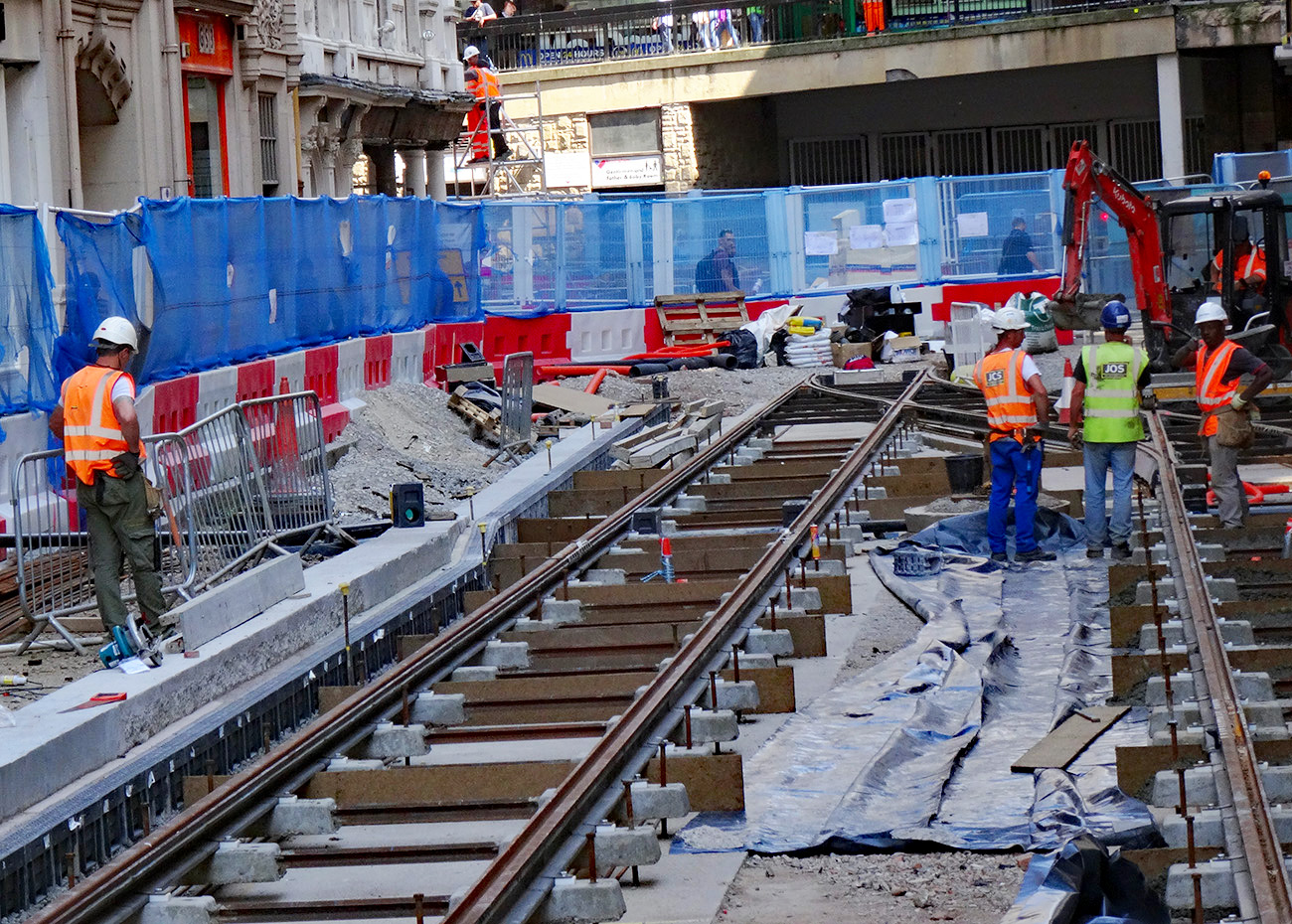 The UK’s poor record on productivity since the 2008 financial crisis is well documented, not least in this blog series. Output per worker has flatlined over the 17 years since the crisis. As was noted in the blog, The UK’s poor productivity record, low UK productivity is caused by a number of factors, including the lack of investment in training, the poor motivation of many workers and the feeling of being overworked, short-termism among politicians and management, and generally poor management practices.
The UK’s poor record on productivity since the 2008 financial crisis is well documented, not least in this blog series. Output per worker has flatlined over the 17 years since the crisis. As was noted in the blog, The UK’s poor productivity record, low UK productivity is caused by a number of factors, including the lack of investment in training, the poor motivation of many workers and the feeling of being overworked, short-termism among politicians and management, and generally poor management practices.
One of the most significant issues identified by analysts and commentators is the lack of investment in physical capital, both by private companies and by the government in infrastructure. Gross fixed capital formation (a measure of investment) has been much lower in the UK compared to international competitors.
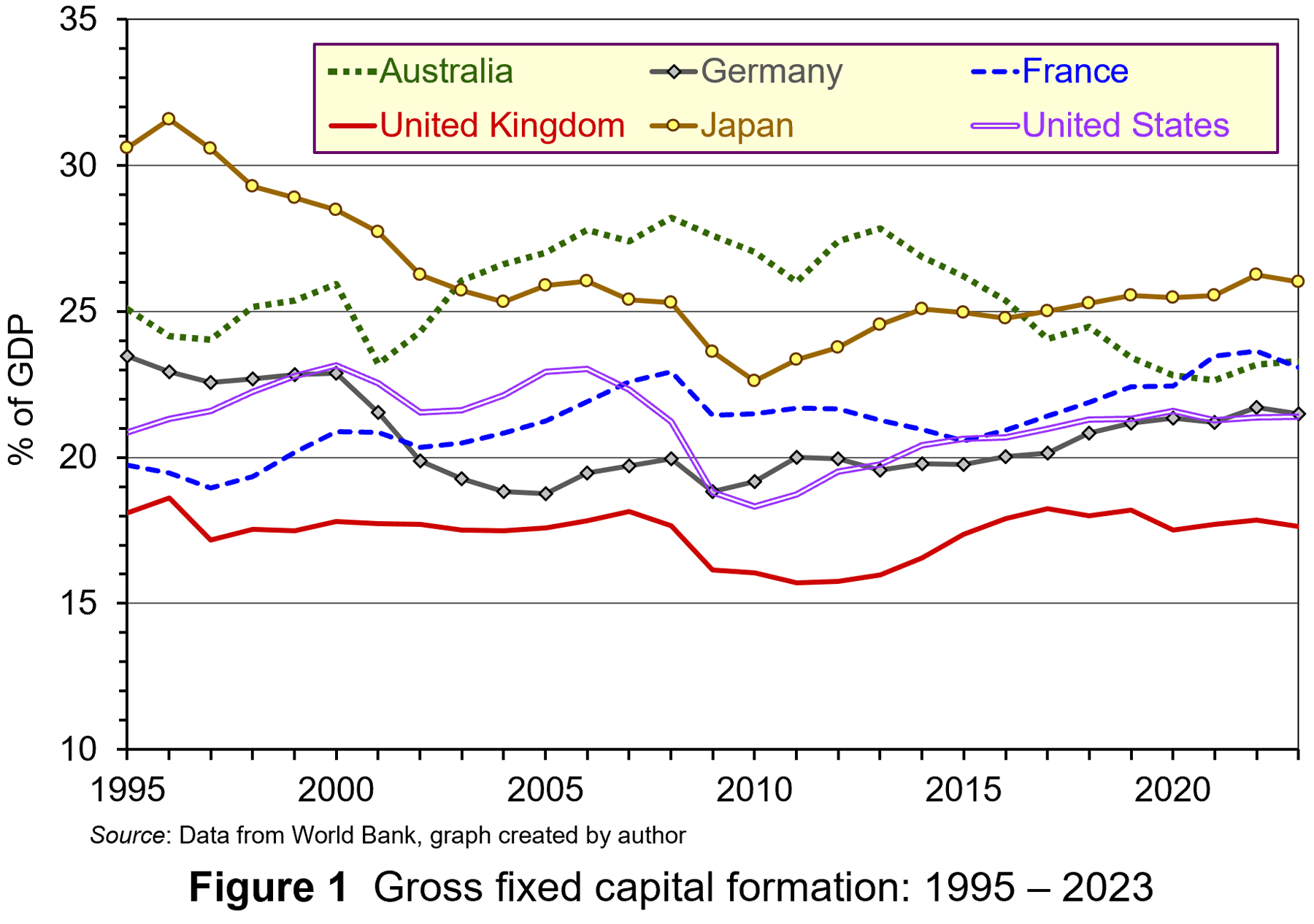 From Figure 1 it can be observed that, since the mid-1990s, the UK has consistently had lower investment as a percentage of GDP compared to other significant developed market economies. The cumulative effect of this gap has contributed to lower productivity and lower economic growth.
From Figure 1 it can be observed that, since the mid-1990s, the UK has consistently had lower investment as a percentage of GDP compared to other significant developed market economies. The cumulative effect of this gap has contributed to lower productivity and lower economic growth.
Interestingly, since the financial crisis, UK firms have had high profitability and associated high cash holdings. This suggests that firms have had a lot of financial resources to reinvest. However, data from the OECD suggests that reinvestment rates in the UK, typically 40–50% of profit, are much lower than in many other OECD countries. In the USA the rate is 50%, in Germany 60–70% and in Japan 70%+. There is much greater emphasis in the UK on returning funds to shareholders through dividends and share buybacks. However, the reinvestment of much of this cash within firms could have gone some way to addressing the UK’s investment gap – but, it hasn’t been done.
 Analysis by the OECD suggest that, while the cost of financing investment has declined since the financial crisis, the gap between this and the hurdle rate used to appraise investments has widened. Between 2010 and 2021 the difference nearly doubled to 4%. This increase in the hurdle rate can be related to increases in the expected rate of return by UK companies and their investors.
Analysis by the OECD suggest that, while the cost of financing investment has declined since the financial crisis, the gap between this and the hurdle rate used to appraise investments has widened. Between 2010 and 2021 the difference nearly doubled to 4%. This increase in the hurdle rate can be related to increases in the expected rate of return by UK companies and their investors.
In this blog we will analyse (re)investment decisions by firms, discussing how increases in the expected rate of return in the UK raise the hurdle rate used to appraise investments. This reduces the incentive to engage in long-term investment. We also discuss policy prescriptions to improve reinvestment rates in the UK.
Investment and the expected rate of return
Investment involves the commitment of funds today to reap rewards in the future. This includes spending on tangible and intangible resources to improve the productive capacity of firms. Firms must decide whether the commitment of funds is worthwhile. To do so, economic theory suggests that they need to consider the compensation required by their provider of finance – namely, investors.
What rewards do investors require to keep their funds invested with the firm?
When conducting investment appraisal, firms compare the estimated rate of return from an investment with the minimum return investors are prepared to receive (termed the ‘expected return’). Normally this is expressed as a percentage of the initial outlay. Firms have to offer returns to investors which are equal to or greater than the minimum expected return – the return that is sufficient to keep funds invested in the firm. Therefore, returns above this minimum expected level are termed ‘excess returns’.
When firms conduct appraisals of potential investments, be it in tangible or intangible capital, they need to take into account the fact that net benefits, expressed as cash flows, will accrue over the life of the investment, not all at once. To do this, they use discounted cash flow (DCF) analysis. This converts future values of the net benefits to their present value. This is expressed as follows:

Where:
NPV = Net present value (discounted net cash flows);
K = Capital outlay (incurred at the present time);
C = Net cash flows (occur through the life of the investment project);
r = Minimum expected rate of return.
In this scenario, the investment involves an initial cash outlay (K), followed in subsequent periods by net cash inflows each period over the life of the investment, which in this case is 25 years. All the cash flows are discounted back to the present so that they can be compared at the same point in time.
The discount rate (r) used in appraisals to determine the present value of net cash flows is determined by the minimum expected return demanded by investors. If at that hurdle rate there are positive net cash flows (+NPV), the investment is worthwhile and should be pursued. Conversely, if at that hurdle rate there are negative net cash flows (–NPV), the investment is not worthwhile and should not be pursued.
According to economic theory, if a firm cannot find any investment projects that produce a positive NPV, and therefore satisfy the minimum expected return, it should return funds to shareholders through dividends or share buybacks so that they can invest the finance more productively.
Firm-level data from the OECD suggest that UK firms have had higher profits and this has been associated with increased cash holdings. But, due to the higher hurdle rate, less investment is perceived to be viable and thus firms distribute more of their profits through dividends and share buybacks. These payouts represent lost potential investment and cumulatively produce a significant dent in the potential output of the UK economy.
Why are expected rates of return higher in the UK?
This higher minimum rate of expected return can be explained by factors influencing its determinants; opportunity cost and risk/uncertainty.
Higher opportunity cost. Opportunity cost relates to the rate of return offered by alternatives. Investors and, by implication firms, will have to consider the rate of return offered by alternative investment opportunities. Typically, investors have focused on interest rates as a measure of opportunity cost. Higher interest rates raise the opportunity cost of an investment and increase the minimum expected rate of return (and vice versa with lower interest rates).
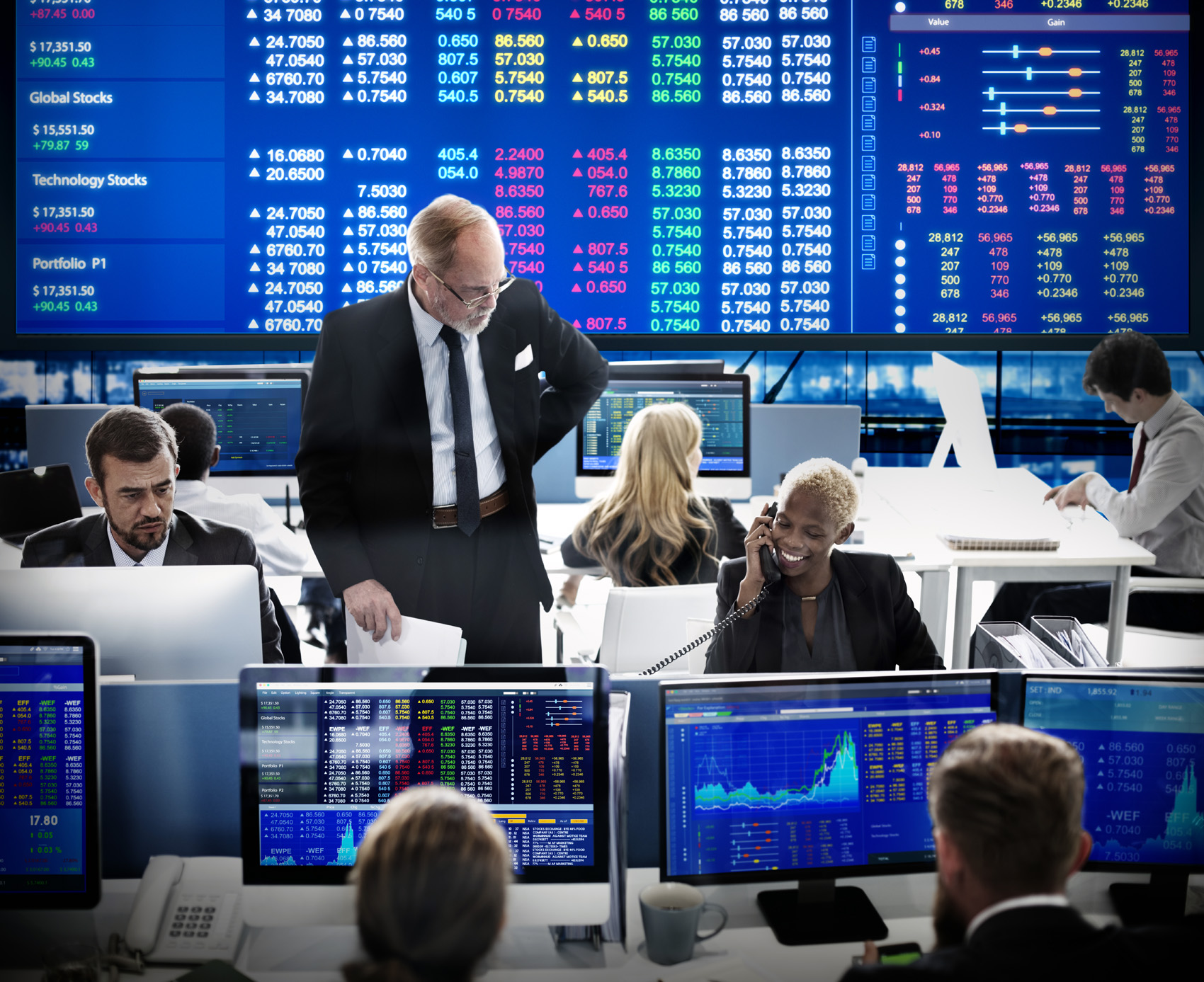 However, it is not interest rates that have increased the opportunity cost, and hence the minimum expected rate of return associated with investment, in the UK since the financial crisis. For most of the period since 2008, interest rates have been extremely low, sitting at below 1%, only rising significantly during the post-pandemic inflationary surge in 2022. This indicates that this source of opportunity cost for the commitment of business investment has been extremely low.
However, it is not interest rates that have increased the opportunity cost, and hence the minimum expected rate of return associated with investment, in the UK since the financial crisis. For most of the period since 2008, interest rates have been extremely low, sitting at below 1%, only rising significantly during the post-pandemic inflationary surge in 2022. This indicates that this source of opportunity cost for the commitment of business investment has been extremely low.
However, there may be alternative sources of opportunity cost which are pushing up the expected rate of return. UK investors are not restricted to investing in the UK and can move their funds between international markets determined by the rate of return offered. The following table illustrates the returns (in terms of percentage stock market index gain) from investing in a sample of UK, US, French and German stock markets between August 2010 and August 2025.
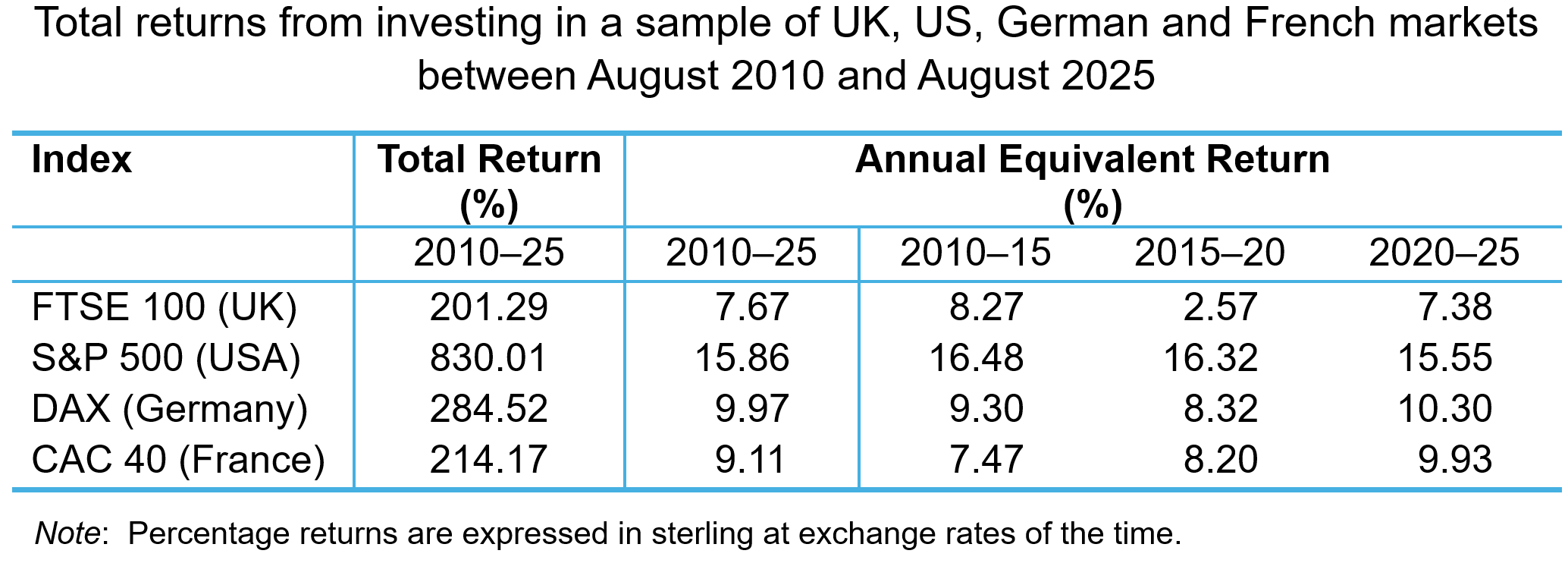
When expressed in sterling, returns offered by UK-listed companies are lower across the whole period and in most of the five-yearly sub-periods. Indeed, the annual equivalent rate of return (AER) for the FTSE 100 index across the whole period is less than half that of the S&P 500. The index offered a paltry annual return of 2.57% between 2015 and 2020, while the US index offered a return of 16.48%. Both the French and German indices offered higher rates of return, in the latter part of the period particularly. This represents a higher opportunity cost for UK investors and may have increased their expectations about the return they require for UK investments.
Greater perceived risk/uncertainty. Expected rates of return are also determined by perceptions of risk and uncertainty – the compensation investors need to bear the perceived risk associated with an investment. Investors are risk averse. They demand higher expected return as compensation for higher perceived risk. Higher levels of risk aversion increase the expected rate of return and related investment hurdle rates.
 There has been much discussion of increased uncertainty and risk aversion among global investors and firms (see the blogs Rising global uncertainty and its effects, World Uncertainty Index, The Chancellor’s fiscal dilemma and Investment set to fall as business is baffled by Trump). The COVID-19 pandemic, inflation shocks, the war in Ukraine, events across the Middle East and the trade policies adopted by the USA in 2025 have combined to produce a very uncertain business environment.
There has been much discussion of increased uncertainty and risk aversion among global investors and firms (see the blogs Rising global uncertainty and its effects, World Uncertainty Index, The Chancellor’s fiscal dilemma and Investment set to fall as business is baffled by Trump). The COVID-19 pandemic, inflation shocks, the war in Ukraine, events across the Middle East and the trade policies adopted by the USA in 2025 have combined to produce a very uncertain business environment.
While these have been relatively recent factors influencing world-wide business uncertainty, perceptions of risk and uncertainty concerning the UK economy seem to be longer established. To measure policy-related economic uncertainty in the UK, Baker, Bloom and Davis at www.PolicyUncertainty.com construct an index based on the content analysis of newspaper articles mentioning terms reflecting policy uncertainty.
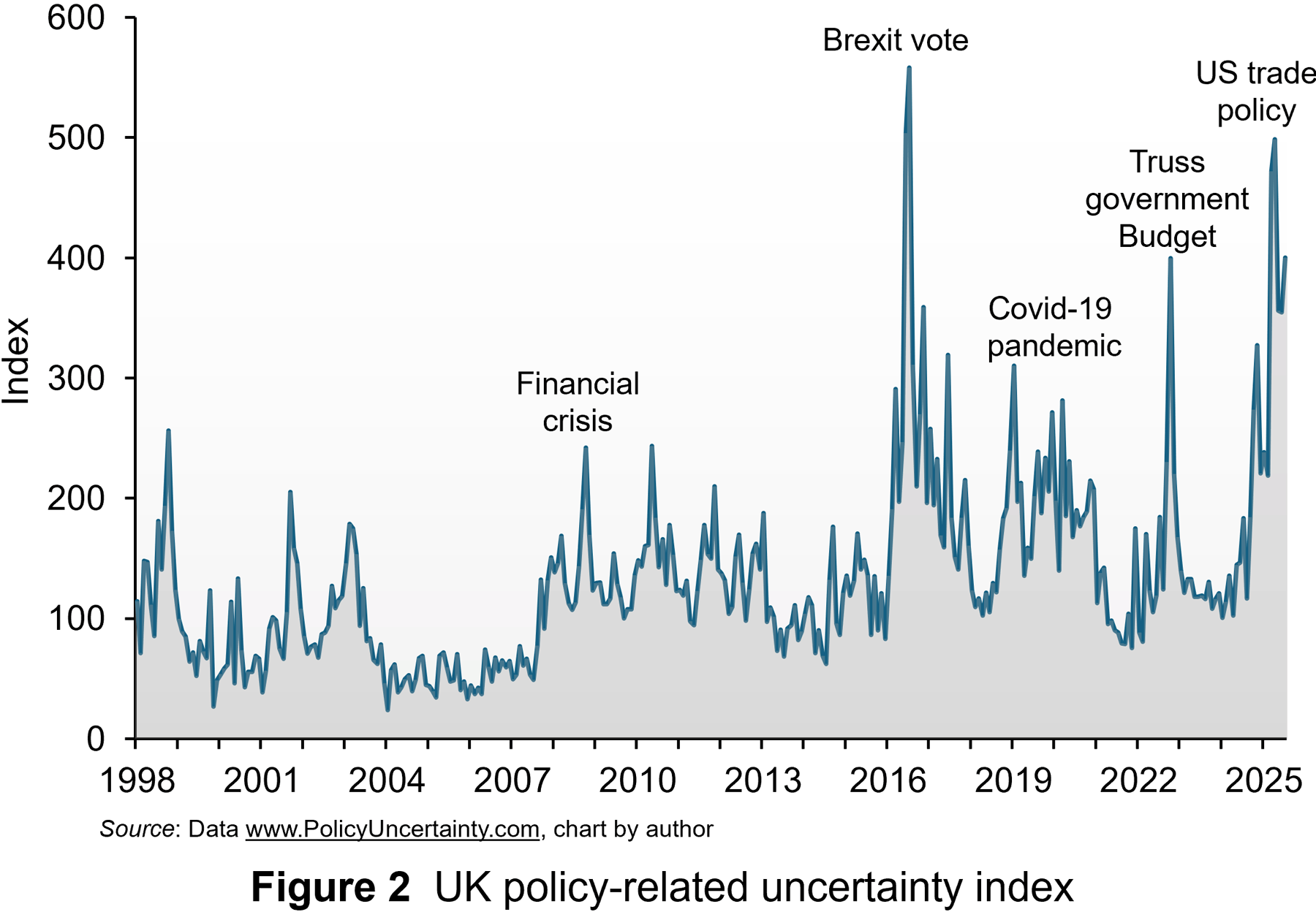 Figure 2 illustrates the monthly index from 1998 to July 2025. The series is normalised to standard deviation 1 prior to 2011 and then summed across papers, by month. Then, the series is normalised to mean 100 prior to 2011.
Figure 2 illustrates the monthly index from 1998 to July 2025. The series is normalised to standard deviation 1 prior to 2011 and then summed across papers, by month. Then, the series is normalised to mean 100 prior to 2011.
Some of the notable spikes in uncertainty in the UK since 2008 have been labelled. Beginning with the global financial crisis, investors and firms became much more uncertain. This was exacerbated by a series of economic shocks that hit the economy, one of which, the narrow vote to leave the European Union in 2016, was specific to the UK. This led to political turmoil and protracted negotiations over the terms of the trade deal after the UK left. This uncertainty has been exacerbated recently by the series of global shocks highlighted above and also the budget uncertainty of Liz Truss’s short-lived premiership and now the growing pressure to reduce government borrowing.
While spikes in uncertainty occurred before the financial crises, the average level of uncertainty, as measured by the index, has been much higher since the crisis. From 1998 to 2008, the average value was 89. Since 2008, the average value has been 163. Since the Brexit vote, the average value has been 185. This indicates a much higher perception of risk and uncertainty over the past 15 year and this translates into higher minimum expected return as compensation. Consequently, this makes many long-term investment projects less viable because of higher hurdle rates. This produces less productive investment in capital, contributing significantly to lower productivity.
Policy proposals
There has been much debate in the UK about promoting greater long-term investment. Reforms have been proposed to improve public participation in long-term investment through the stock market. To boost investment, this would require the investing public to be prepared to accept lower expected returns for a given level of risk or accept higher risk for a given level of returns.
Evidence suggests that the appetite for this may be very low. UK savers tend to favour less risky and more liquid cash deposits. It may be difficult to encourage them to accept higher levels of risk. In any case, even if they did, many may invest outside the UK where the risk-return trade-off is more favourable.
 Over the past 10 years, policy uncertainty has played a significant role in deterring investment. So, if there is greater continuity, this may then promote higher levels of investment.
Over the past 10 years, policy uncertainty has played a significant role in deterring investment. So, if there is greater continuity, this may then promote higher levels of investment.
The Labour government has proposed policies which aim to share or reduce the risk/uncertainty around long-term investment for UK businesses. For instance, a National Wealth Fund (NWF) has been established to finance strategic investment in areas such as clean energy, gigafactories and carbon capture. Unfortunately, the Fund is financed by borrowing through financial markets and the amount expected to be committed over the life of the current Parliament is only £29 billion, assuming that private capital matches public commitments in the ratio expected. It is questionable whether the Fund’s commitment will be sufficient to attract private capital.
Alternatively, Invest 2035 is a proposal to create a stable, long-term policy environment for business investment. It aims to establish an Industrial Strategy Council for policy continuity and to tackle issues like improving infrastructure, reducing energy costs and addressing skills gaps. Unfortunately, even if there is some attempt at domestic policy stability, the benefits may be more than offset by perceptions around global uncertainty, which may mean that UK investors’ minimum expected rates of return remain high and long-term investment low for the foreseeable future.
Articles
Data
Questions
- Use the marginal efficiency of capital framework to illustrate the ‘lost’ investment spending in the UK due to the investment hurdle rate being higher than the cost of capital.
- Explain the arbitrage process which produces the differences in valuations of UK securities and foreign ones due to differences in the expected rate of return.
- Sketch an indifference curve for a risk-averse investor, treating expected return and risk as two characteristics of a financial instrument.
- How does higher uncertainty affect the slope of an indifference curve for such an investor? How does this affect their investment hurdle rate?
- Analyse the extent to which the proposed polices can reduce the investment hurdle rate for UK companies and encourage greater levels of investment.
 The UK energy regulator, Ofgem, has announced that the UK energy price cap will rise in October by an average of 2%. The energy price cap sets the maximum prices for electricity and gas that can be charged by suppliers to households. For those paying by direct debit, the maximum electricity price per kilowatt-hour (kWh) will rise from 25.73p to 26.35p, with the maximum daily standing charge rising from 51.37p to 53.68p. As far as gas is concerned, the maximum price per kWh will fall slightly from 6.33p to 6.29p, with the maximum daily standing charge rising from 29.82p to 34.03p. Ofgem estimates that this will mean that the capped cost to the average household will rise from £1720 to £1755.
The UK energy regulator, Ofgem, has announced that the UK energy price cap will rise in October by an average of 2%. The energy price cap sets the maximum prices for electricity and gas that can be charged by suppliers to households. For those paying by direct debit, the maximum electricity price per kilowatt-hour (kWh) will rise from 25.73p to 26.35p, with the maximum daily standing charge rising from 51.37p to 53.68p. As far as gas is concerned, the maximum price per kWh will fall slightly from 6.33p to 6.29p, with the maximum daily standing charge rising from 29.82p to 34.03p. Ofgem estimates that this will mean that the capped cost to the average household will rise from £1720 to £1755.
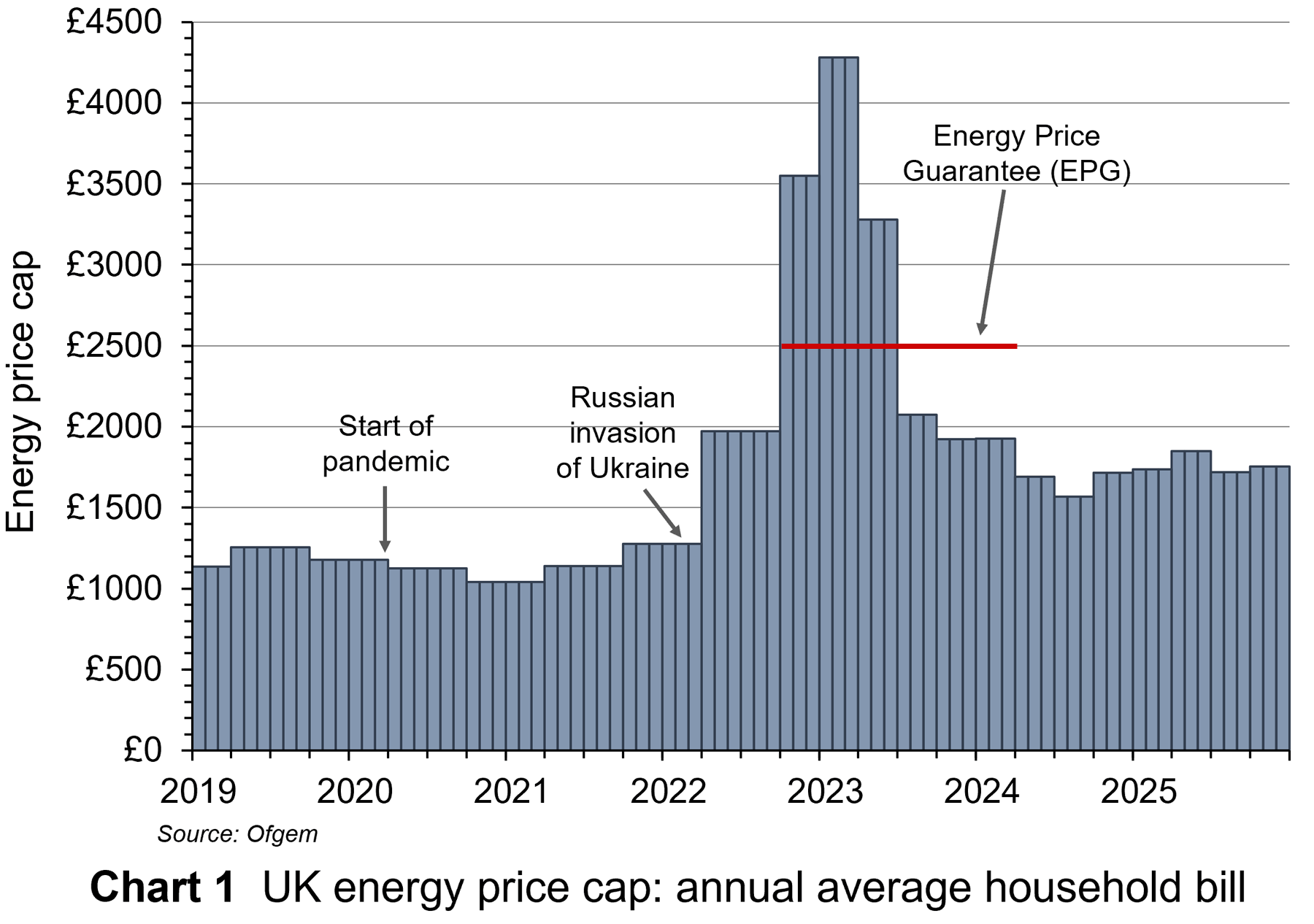 The average capped cost is now much lower than the peak of £4279 from January to March 2023. This followed the huge increase in international gas prices in the aftermath of the invasion of Ukraine and the cutting off of gas supplies from Russia. Note that although the suppliers received these capped prices, average consumers’ bills were limited to £2500 from October 2022 to March 2024 under the government’s Energy Price Guarantee scheme, with suppliers receiving a subsidy from the government to make up the shortfall. But despite today’s cap being much lower than at the peak, it is still much higher than the cap of £1277 prior to Russia’s invasion of Ukraine: see Chart 1 (click here for a PowerPoint).
The average capped cost is now much lower than the peak of £4279 from January to March 2023. This followed the huge increase in international gas prices in the aftermath of the invasion of Ukraine and the cutting off of gas supplies from Russia. Note that although the suppliers received these capped prices, average consumers’ bills were limited to £2500 from October 2022 to March 2024 under the government’s Energy Price Guarantee scheme, with suppliers receiving a subsidy from the government to make up the shortfall. But despite today’s cap being much lower than at the peak, it is still much higher than the cap of £1277 prior to Russia’s invasion of Ukraine: see Chart 1 (click here for a PowerPoint).
So is the capped price purely a reflection of the international price of gas, or is it more complicated? The picture is slightly different for gas and electricity.
Gas prices
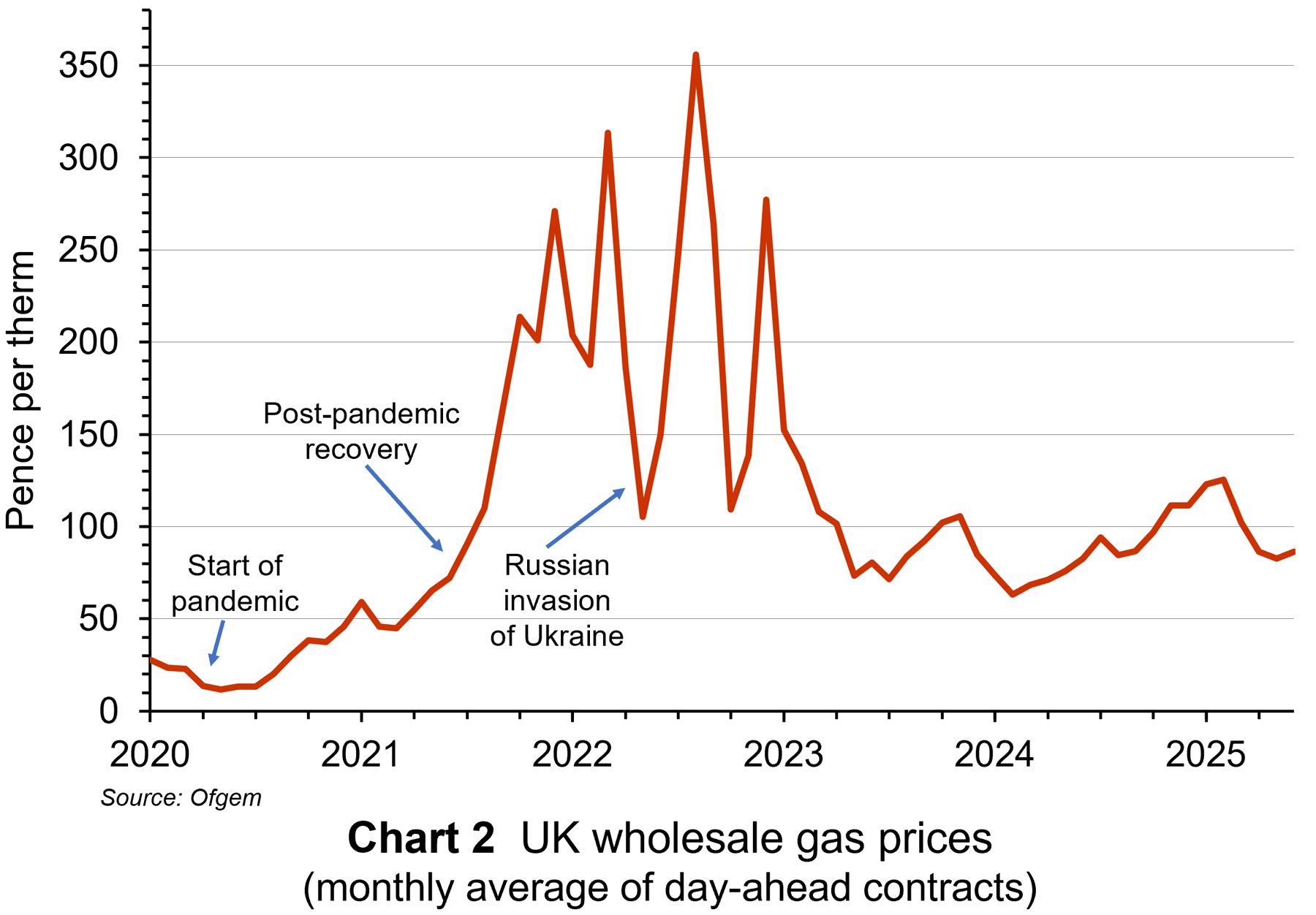 As far as gas prices are concerned, the price does largely reflect the international price: see Chart 2 (click here for a PowerPoint).
As far as gas prices are concerned, the price does largely reflect the international price: see Chart 2 (click here for a PowerPoint).
The UK is no longer self-sufficient in gas and relies in part on imported gas, with the price determined in volatile international markets. It also has low gas storage capacity compared with most other European countries. This leaves it highly reliant on volatile global markets in periods of prolonged high demand, like a cold winter. Is such cases, the UK often has to purchase more expensive liquefied natural gas (LNG) from global suppliers.
Additionally, taxes, environmental levies and the costs of the nationwide gas distribution network contribute to the overall price for consumers. Changes in these costs affect gas prices. These are itemised below in the case of electricity.
With electricity pricing, the picture is more complex.
Electricity prices
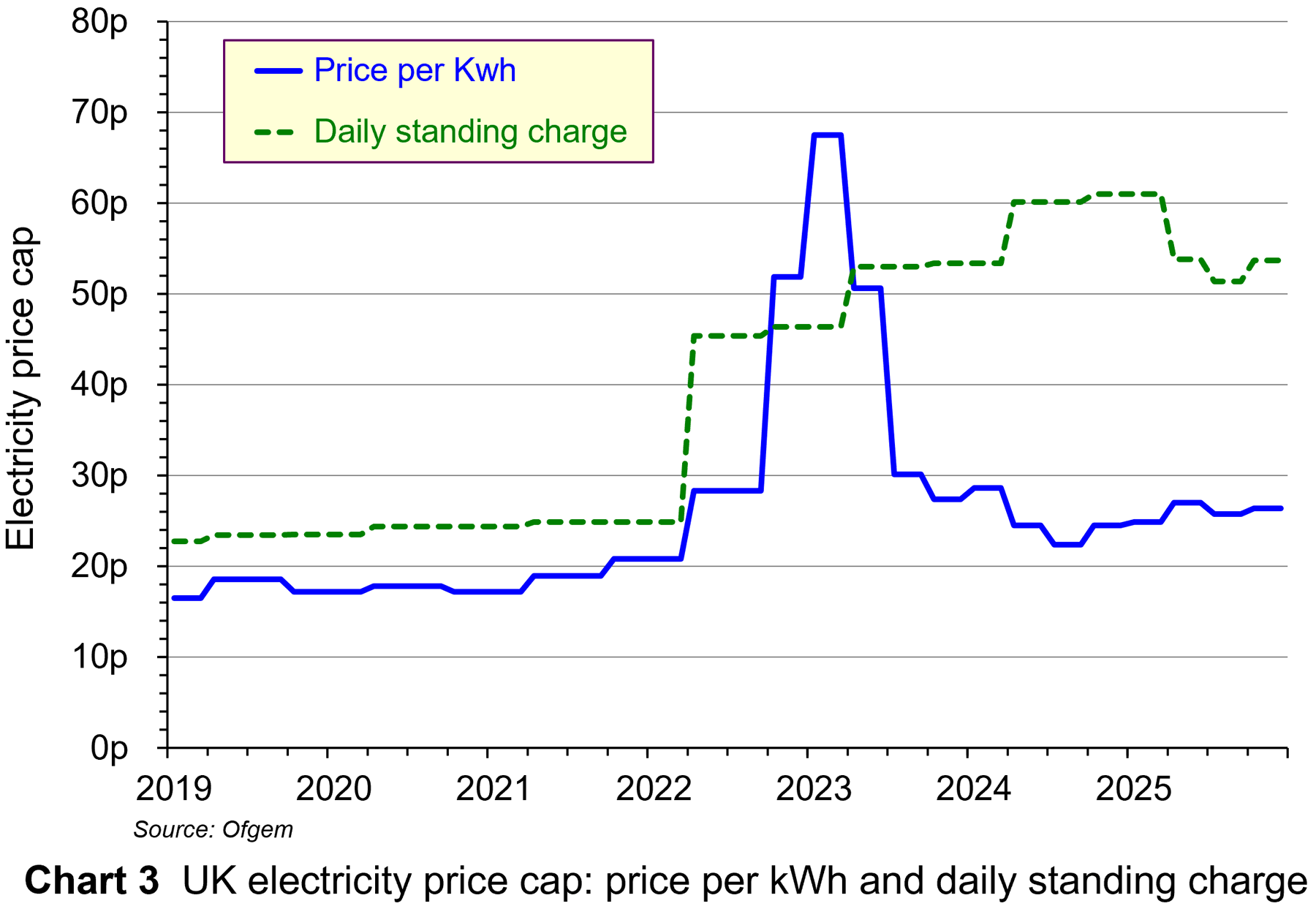 Electricity generation costs vary considerably with the different methods. Renewable sources like wind and solar have the lowest marginal costs, while natural gas plants have the highest, although gas prices fluctuate considerably.
Electricity generation costs vary considerably with the different methods. Renewable sources like wind and solar have the lowest marginal costs, while natural gas plants have the highest, although gas prices fluctuate considerably.
So how are consumer electricity prices determined? And how is the electricity price cap determined? The price cap for electricity per kWh and the daily standing charge for electricity are shown in Chart 3 (click here for a PowerPoint).
Marginal cost pricing. The wholesale price of electricity in the UK market is set by the most expensive power source needed to meet demand on a day-by-day basis. This is typically gas. This means that even when cheaper renewables (wind, solar, hydro) or nuclear power generate most of the electricity, high gas prices can increase the cost for all electricity. The wholesale price accounts for around 41% of the retail price paid by households.
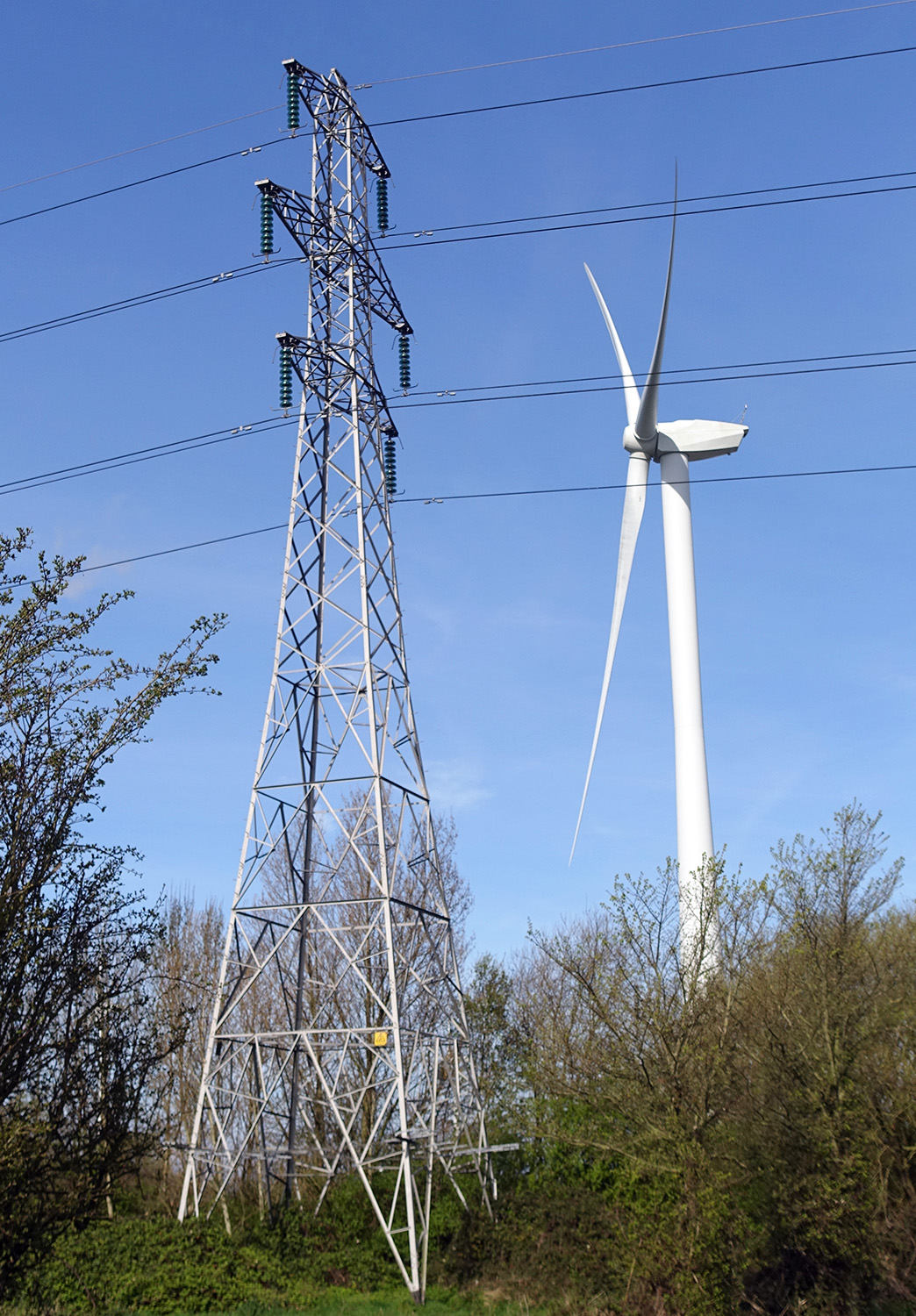 It also means that profits for low-marginal-cost producers could increase significantly when gas prices rise. To prevent such (low-carbon) suppliers making excess profits when the wholesale price is high and possibly making a loss when it is low, the actual prices that they receive is negotiated in advance and a contract is signed. These contracts are known as Contracts for Difference (CfDs). CfDs provide a fixed ‘strike price’ to low-carbon generators. The strike price is set so as to allow low-carbon generators to recoup capital costs and is thus set above the typical level of marginal cost. If the wholesale price is below the strike price, payments to generators to cover the difference are funded by amounts collected from electricity suppliers in advance using the CfD Supplier Obligation Levy. If the wholesale price is above the strike price, the difference is returned to consumers in terms of lower electricity bills.
It also means that profits for low-marginal-cost producers could increase significantly when gas prices rise. To prevent such (low-carbon) suppliers making excess profits when the wholesale price is high and possibly making a loss when it is low, the actual prices that they receive is negotiated in advance and a contract is signed. These contracts are known as Contracts for Difference (CfDs). CfDs provide a fixed ‘strike price’ to low-carbon generators. The strike price is set so as to allow low-carbon generators to recoup capital costs and is thus set above the typical level of marginal cost. If the wholesale price is below the strike price, payments to generators to cover the difference are funded by amounts collected from electricity suppliers in advance using the CfD Supplier Obligation Levy. If the wholesale price is above the strike price, the difference is returned to consumers in terms of lower electricity bills.
Policy costs. Electricity bills include an element to fund various social and environmental objectives. This element is also included in the cap. From October to December 2025, this element of the cap will be 11.3%. The money helps to subsidise low-carbon energy generation and fund energy efficiency schemes. It also funds the Warm Home Discount (WHD). In the October to December 2025 price cap, this amounted to a discount for eligible low-income and vulnerable households of £150 per annum on their electricity bills. The WHD element is included in the standing charge in the price cap. From October 2025, more generous terms will mean that the number of households receiving WHD will increase from 3.4 million to 6.1 million households. This is the main reason for the £35 increase in the cap.
Network costs. These include the cost of building, maintaining and repairing the pipes and wires that deliver gas and electricity to homes. From October to December 2025, this element of the cap will be 22.6%.
Supplier business costs. These include operating costs (billing, metering, office costs, etc.) and servicing debt. From October to December 2025, this element of the cap will be 15.4%.
Profit Allowance. A small percentage is added to the price cap for energy suppliers’ profits. This is known as the Earnings Before Interest and Tax (EBIT) allowance and is around 2.4%. This has a fixed component that does not change when the overall price cap is updated and a variable component that rises or falls with changes in the cap.
Reliance on gas, low gas storage facilities, marginal cost pricing and the commitment to invest in low-carbon electricity and home heating all add to the costs of energy in the UK, making UK electricity prices among the highest in the world.
Articles
Information and Data
Questions
- Why are the UK’s energy prices among the highest in the world?
- What are the arguments for and against subsidising wind power?
- What is the Contracts for Difference scheme in low-carbon energy. What CfDs have been awarded? Assess the desirability of the scheme.
- Is the capping of gas and electricity prices the best way of providing support for low-income and vulnerable consumers?
- How are externalities relevant in determining the optimal pricing of electricity?
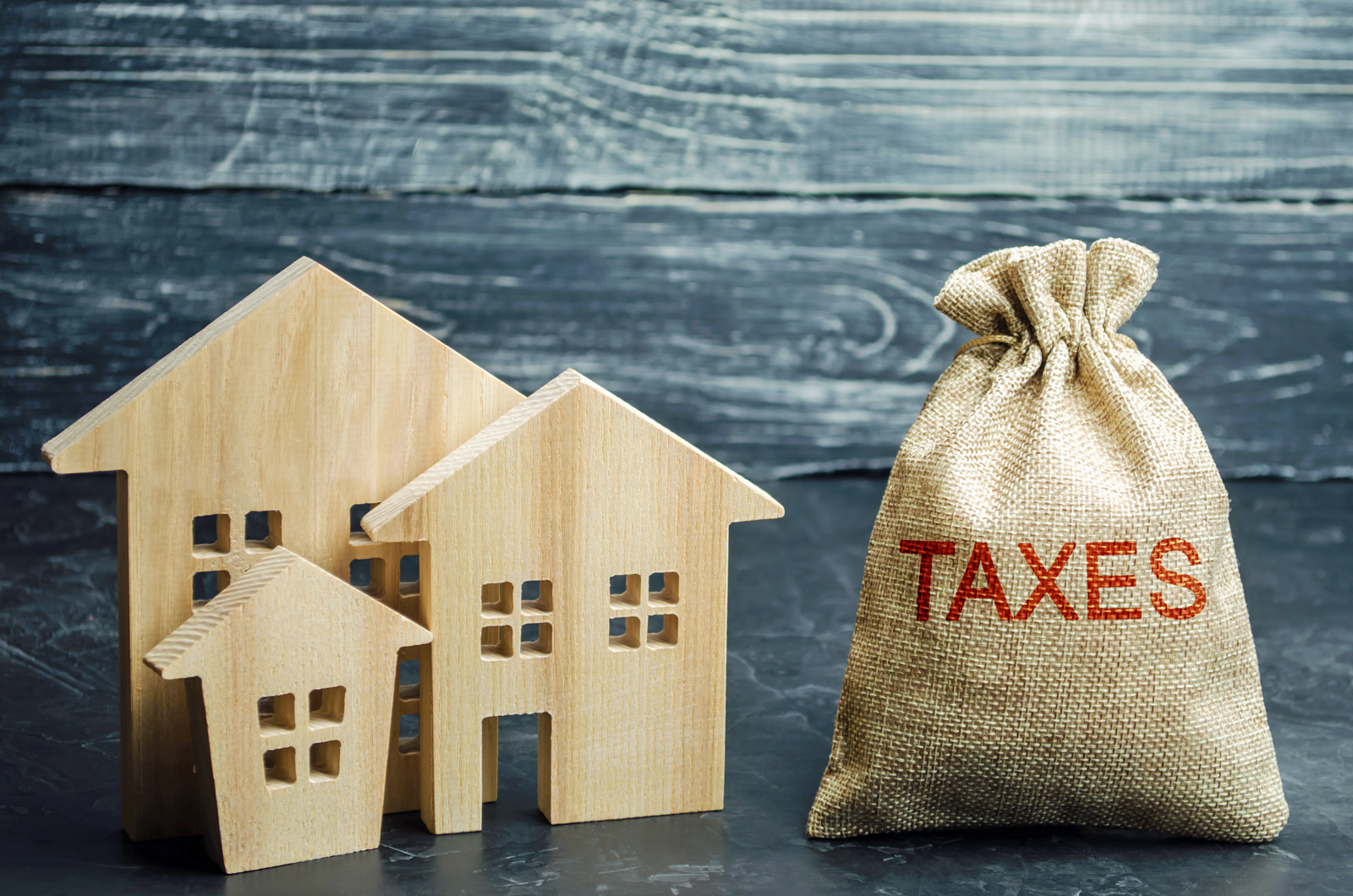 The UK Chancellor of the Exchequer, Rachel Reeves, will present her annual Budget in late autumn. It will involve some hard economic and political choices. The government would like to spend more money on improving public services but has pledged not to raise taxes ‘on working people’, which is interpreted as not raising the rates of income tax, national insurance for employees and the self-employed, and VAT. What is more, government borrowing is forecast by the OBR to be £118 billion, or nearly 4.0% of GDP, for the the year 2025/26. This is a fall from the 5.1% in 2024/25 and is well below the 15.0% in 2020/21 during the pandemic. But it is significantly above the 2.1% in 2018/19.
The UK Chancellor of the Exchequer, Rachel Reeves, will present her annual Budget in late autumn. It will involve some hard economic and political choices. The government would like to spend more money on improving public services but has pledged not to raise taxes ‘on working people’, which is interpreted as not raising the rates of income tax, national insurance for employees and the self-employed, and VAT. What is more, government borrowing is forecast by the OBR to be £118 billion, or nearly 4.0% of GDP, for the the year 2025/26. This is a fall from the 5.1% in 2024/25 and is well below the 15.0% in 2020/21 during the pandemic. But it is significantly above the 2.1% in 2018/19.
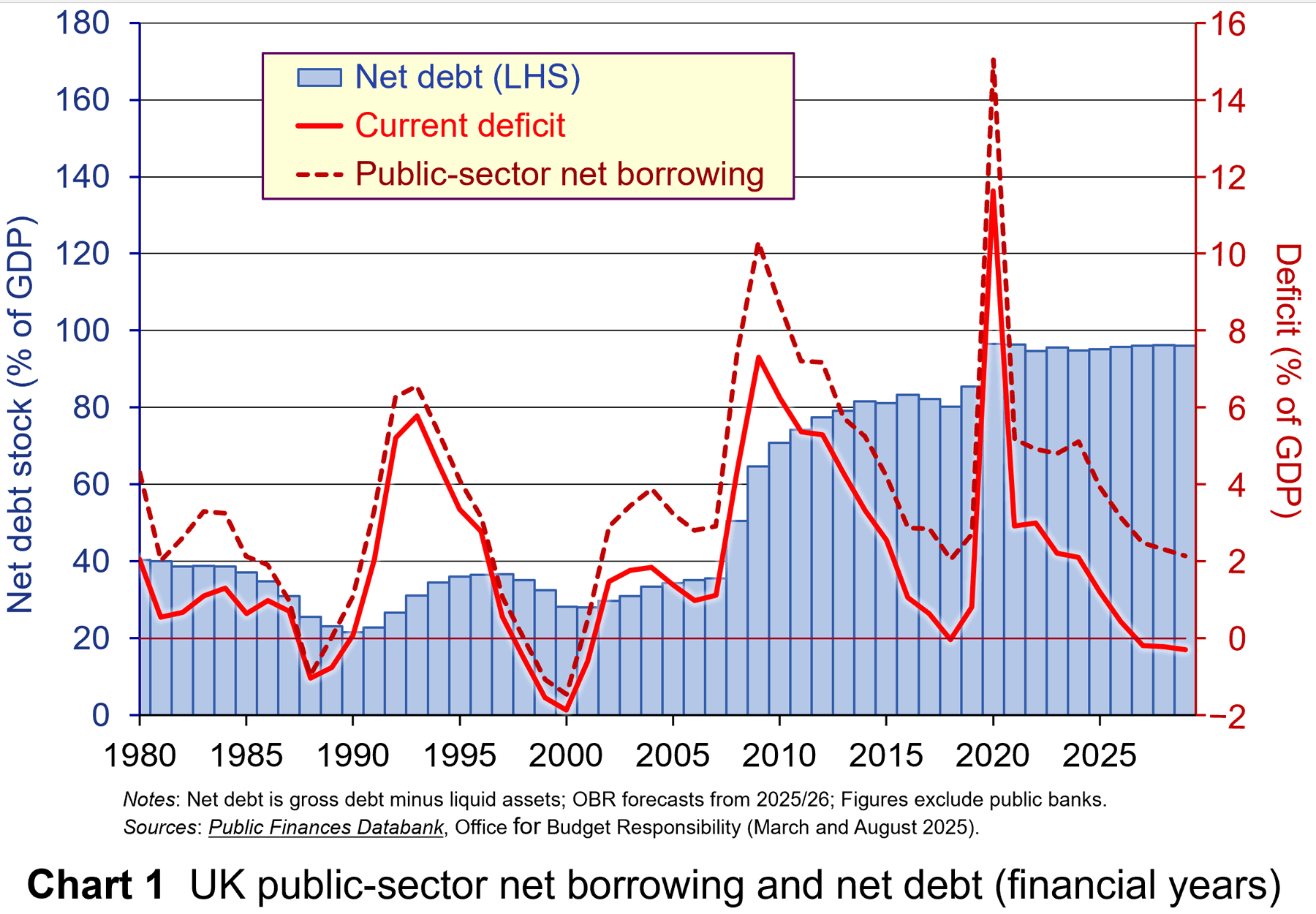 The government has pledged to stick to its two fiscal rules. The first is that the day-to-day, or ‘current’, budget (i.e. excluding investment) should be in surplus or in deficit of no more than 0.5 per cent of GDP by 2029/30 (or the third year of the rolling forecast period from the 2026/27 Budget). This allows investment to be funded by borrowing. The second rule is that public-sector net debt, which includes public-sector debt plus pension liabilities minus equity, loans and other financial assets, should be falling by 2029/30 (or the third year of the rolling forecast period from the 2026/27 Budget). The current budget deficit (i.e. excluding borrowing for investment) was forecast by the OBR in March to be 1.2% of GDP for 2025/26 (see Chart 1) and to be a surplus of 0.3% in 2029/30 (£9.9 billion). (Click here for a PowerPoint of the chart.)
The government has pledged to stick to its two fiscal rules. The first is that the day-to-day, or ‘current’, budget (i.e. excluding investment) should be in surplus or in deficit of no more than 0.5 per cent of GDP by 2029/30 (or the third year of the rolling forecast period from the 2026/27 Budget). This allows investment to be funded by borrowing. The second rule is that public-sector net debt, which includes public-sector debt plus pension liabilities minus equity, loans and other financial assets, should be falling by 2029/30 (or the third year of the rolling forecast period from the 2026/27 Budget). The current budget deficit (i.e. excluding borrowing for investment) was forecast by the OBR in March to be 1.2% of GDP for 2025/26 (see Chart 1) and to be a surplus of 0.3% in 2029/30 (£9.9 billion). (Click here for a PowerPoint of the chart.)
The OBR’s March forecasts, therefore, were that the rules would be met with current policies and that the average rate of economic growth would be 1.8% over the next four years.
However, there would be very little room for manoeuvre, and with global political and economic uncertainty, including the effects of tariffs, climate change on harvests and the continuing war in Ukraine, the rate of economic growth might be well below 1.8%.
The March forecasts were based on the assumption that inflation would fall and hence that the Bank of England would reduce interest rates. Global pressure on inflation, however, might result in inflation continuing to be above the Bank of England’s target of 2%. This would mean that interest rates would be slow to fall – if at all. This would dampen growth and make it more expensive for the government to service the public-sector debt, thus making it harder to reduce the public-sector deficit.
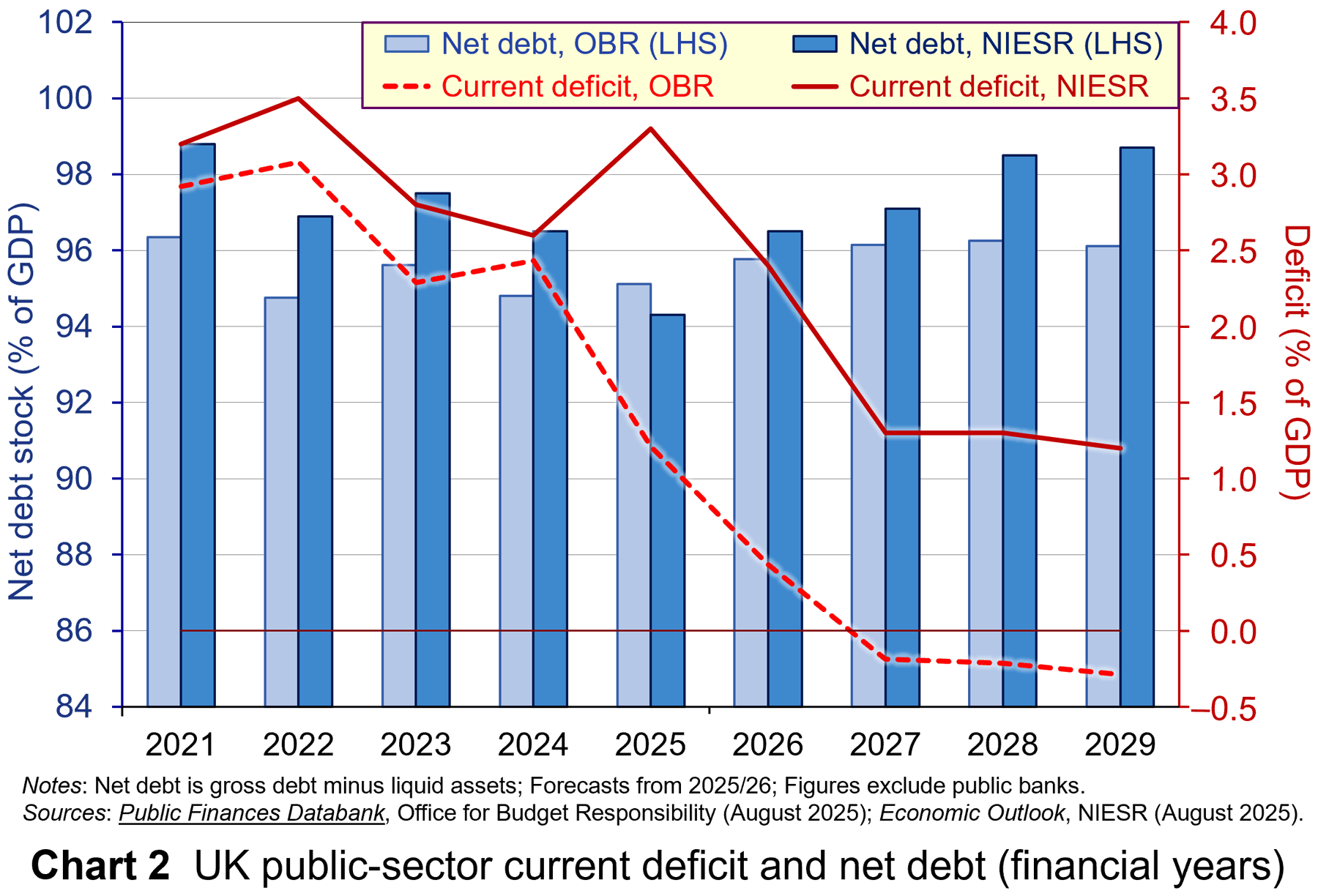 A forecast earlier this month by the National Institute for Economic and Social Research (NIESR) (see link below and Chart 2) reflects these problems and paints a gloomier picture than the OBR’s March forecast. The NIESR forecasts that GDP will grow by only 1.3 per cent in 2025, 1.2 per cent in 2026, 1.1% in 2027 and 1.0% in 2028, with the average for 2025 to 2023 being 1.13%. This is the result of high levels of business uncertainty and the effects of tariffs on exports. With no change in policy, the current deficit would be £41.2 billion in the 2029/30 financial year. Inflation would fall somewhat, but would stick at around 2.7% from 2028 to 2030. Net debt would be rising in 2029/30 &ndash but only slightly, from 98.7% to 99.0%. (Click here for a PowerPoint of the chart.)
A forecast earlier this month by the National Institute for Economic and Social Research (NIESR) (see link below and Chart 2) reflects these problems and paints a gloomier picture than the OBR’s March forecast. The NIESR forecasts that GDP will grow by only 1.3 per cent in 2025, 1.2 per cent in 2026, 1.1% in 2027 and 1.0% in 2028, with the average for 2025 to 2023 being 1.13%. This is the result of high levels of business uncertainty and the effects of tariffs on exports. With no change in policy, the current deficit would be £41.2 billion in the 2029/30 financial year. Inflation would fall somewhat, but would stick at around 2.7% from 2028 to 2030. Net debt would be rising in 2029/30 &ndash but only slightly, from 98.7% to 99.0%. (Click here for a PowerPoint of the chart.)
So what are the policy options open to the government for dealing with a forecast current budget deficit of £41.2 billion (1.17% of GDP)? There are only three broad options.
Increase borrowing
One approach would be to scrap the fiscal rules and accept increased borrowing – at least temporarily. This would avoid tax increases or expenditure cuts. By running a larger budget deficit, this Keynesian approach would also have the effect of increasing aggregate demand and, other things being equal, could lead to a multiplied rise in national income. This in turn would lead to higher tax revenues and thereby result in a smaller increase in borrowing.
There are two big problems with this approach, however.
The first is that it would, over time, increase the public-sector debt and would involve having to spend more each year on servicing that debt. This would leave less tax revenue for current spending or investment. It would also involve having to pay higher interest rates to encourage people to buy the additional new government bonds necessary to finance the increased deficit.
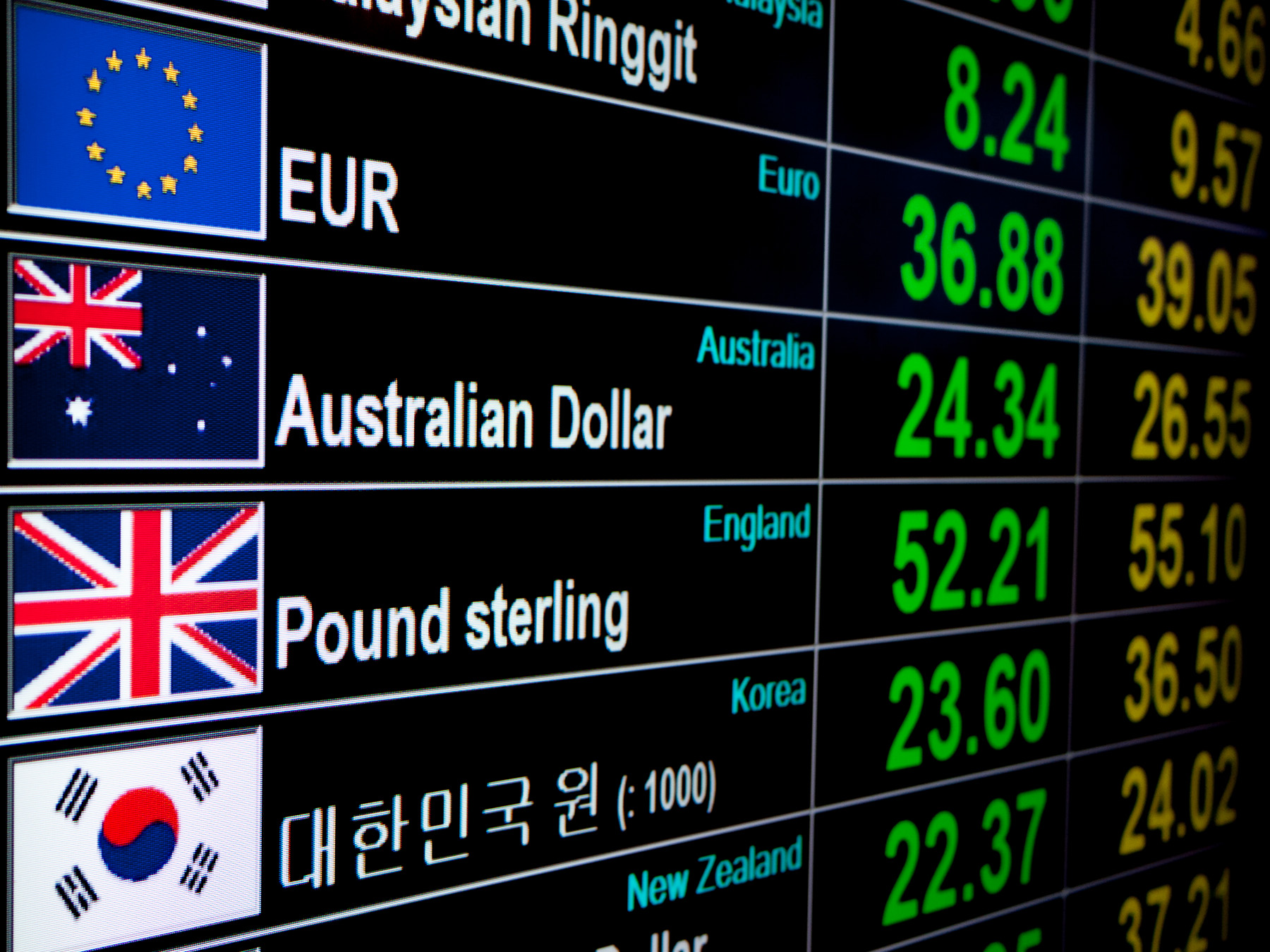 The second problem is that the Chancellor has said that she will stick to the fiscal rules. If she scraps them, if only temporarily, she runs the risk of losing the confidence of investors. This could lead to a run on the pound and even higher interest rates. This was a problem under the short-lived Liz Truss government when the ‘mini’ Budget of September 2022 made unfunded pledges to cut taxes. There was a run on the pound and the Bank of England had to make emergency gilt purchases.
The second problem is that the Chancellor has said that she will stick to the fiscal rules. If she scraps them, if only temporarily, she runs the risk of losing the confidence of investors. This could lead to a run on the pound and even higher interest rates. This was a problem under the short-lived Liz Truss government when the ‘mini’ Budget of September 2022 made unfunded pledges to cut taxes. There was a run on the pound and the Bank of England had to make emergency gilt purchases.
One possibility that might be more acceptable to markets would be to rewrite the investment rule. There could be a requirement on government to invest a certain proportion of GDP (say, 3%) and fund it by borrowing. The supply-side benefits could be faster growth in potential output and higher tax revenue over the longer term, allowing the current deficit rule to be met.
Cut government expenditure
Politicians, especially in opposition, frequently claim that the solution is to cut out public-sector waste. This would allow public expenditure to be cut without cutting services. This, however, is harder than it might seem. There have been frequent efficiency drives in the public sector, but from 1919 to 2023 public-sector productivity fell by an average of 0.97% per year.
Causes include: chronic underinvestment in capital, resulting in outdated equipment and IT systems and crumbling estates; decades of underfunding that have left public services with crumbling estates, outdated equipment and insufficient IT systems; inconsistent, short-term government policy, with frequent changes in government priorities; bureaucratic systems relying on multiple legacy IT systems; workforce challenges, especially in health and social care, with high staff turnover, recruitment difficulties, and a lack of experienced staff.
 The current government has launched a Public Sector Productivity Programme. This is a a cross-government initiative to improve productivity across public services. Departments are required to develop productivity plans to invest in schemes designed to achieve cost savings and improve outcomes in areas such as the NHS, police, and justice system. A £1.8 billion fund was announced in March 2024, to support public-sector productivity improvements and digital transformation. Part of this is to be invested in digital services and AI to improve efficiency. According to the ONS, total public-service productivity in the UK grew by 1.0% in the year to Q1 2025; healthcare productivity grew 2.7% over the same period. It remains to be seen whether this growth in productivity will be maintained. Pressure from the public, however, will mean that any gains are likely to be in terms of improved services rather than reduced government expenditure.
The current government has launched a Public Sector Productivity Programme. This is a a cross-government initiative to improve productivity across public services. Departments are required to develop productivity plans to invest in schemes designed to achieve cost savings and improve outcomes in areas such as the NHS, police, and justice system. A £1.8 billion fund was announced in March 2024, to support public-sector productivity improvements and digital transformation. Part of this is to be invested in digital services and AI to improve efficiency. According to the ONS, total public-service productivity in the UK grew by 1.0% in the year to Q1 2025; healthcare productivity grew 2.7% over the same period. It remains to be seen whether this growth in productivity will be maintained. Pressure from the public, however, will mean that any gains are likely to be in terms of improved services rather than reduced government expenditure.
Increase taxes
This is always a controversial area. People want better public services but also reduced taxes – at least for themselves! Nevertheless, it is an option seriously being considered by the government. However, if it wants to avoid raising the rates of income tax, national insurance for employees and the self-employed, and VAT, its options are limited. It has also to consider the political ramifications of taking unpopular tax-raising measures. The following are possibilities:
Continue the freeze on income tax bands. They are currently frozen until April 2028. The extra revenue from extending the freeze until April 2030 would be around £7 billion. Although this may be politically more palatable than raising the rate of income tax, the revenue raised will be well short of the amount required and thus other measures will be required. Although some £40 billion will have been raised up to 2028 (which has already been factored in), as inflation falls, so the fiscal drag effect will fall: nominal incomes will need to rise less to achieve any given rise in real incomes.
 Cutting tax relief for pensions. Currently, people get income tax relief at their marginal rate on pension contributions made by themselves and their employer up to £60 000 per year or 100% of their earnings, whichever is smaller. When people draw on their pension savings, they pay income tax at their marginal rate, even if the size of their savings has grown from capital gains, interest or dividends. Reducing the limits or restricting relief to the basic rate of tax could make a substantial contribution to increasing government revenue. In 2023/24, pension contribution relief cost the government £52 billion. Restricting relief to the basic rate or cutting the annual limit would make the relief less regressive. In such a case, when people draw on their pension savings, the income tax rate could be limited to the basic rate to avoid double taxation.
Cutting tax relief for pensions. Currently, people get income tax relief at their marginal rate on pension contributions made by themselves and their employer up to £60 000 per year or 100% of their earnings, whichever is smaller. When people draw on their pension savings, they pay income tax at their marginal rate, even if the size of their savings has grown from capital gains, interest or dividends. Reducing the limits or restricting relief to the basic rate of tax could make a substantial contribution to increasing government revenue. In 2023/24, pension contribution relief cost the government £52 billion. Restricting relief to the basic rate or cutting the annual limit would make the relief less regressive. In such a case, when people draw on their pension savings, the income tax rate could be limited to the basic rate to avoid double taxation.
Raising the rate of inheritance tax (IHT) or reducing the threshold. Currently, estates worth more than £325 000 are taxed at a marginal rate of 40%. The threshold is frozen until 2029/30 and thus additional revenue will be received by the government as asset prices increase. If the rate is raised above 40%, perhaps in bands, or the threshold were lowered, then this will earn additional revenue. However, the amount will be relatively small compared to the predicted current deficit in 2029/30 of £41 billion. Total IHT revenue in 2022/23 was only 6.7 billion. Also, it is politically dangerous as people could claim that the government was penalising people who had saved in order to help the next generation, who are struggling with high rents or mortgages.
Increased taxes on business. The main rate of corporation tax was raised from 19% to 25% in April 2023 and the employers’ national insurance rate was raised from 13.8% to 15% and the threshold reduced from £9100 to £5000 per year in April 2025. There is little or no scope for raising business taxes without having significant disincentive effects on investment and employment. Also, there is the danger that raising rates might prompt companies to relocate abroad.
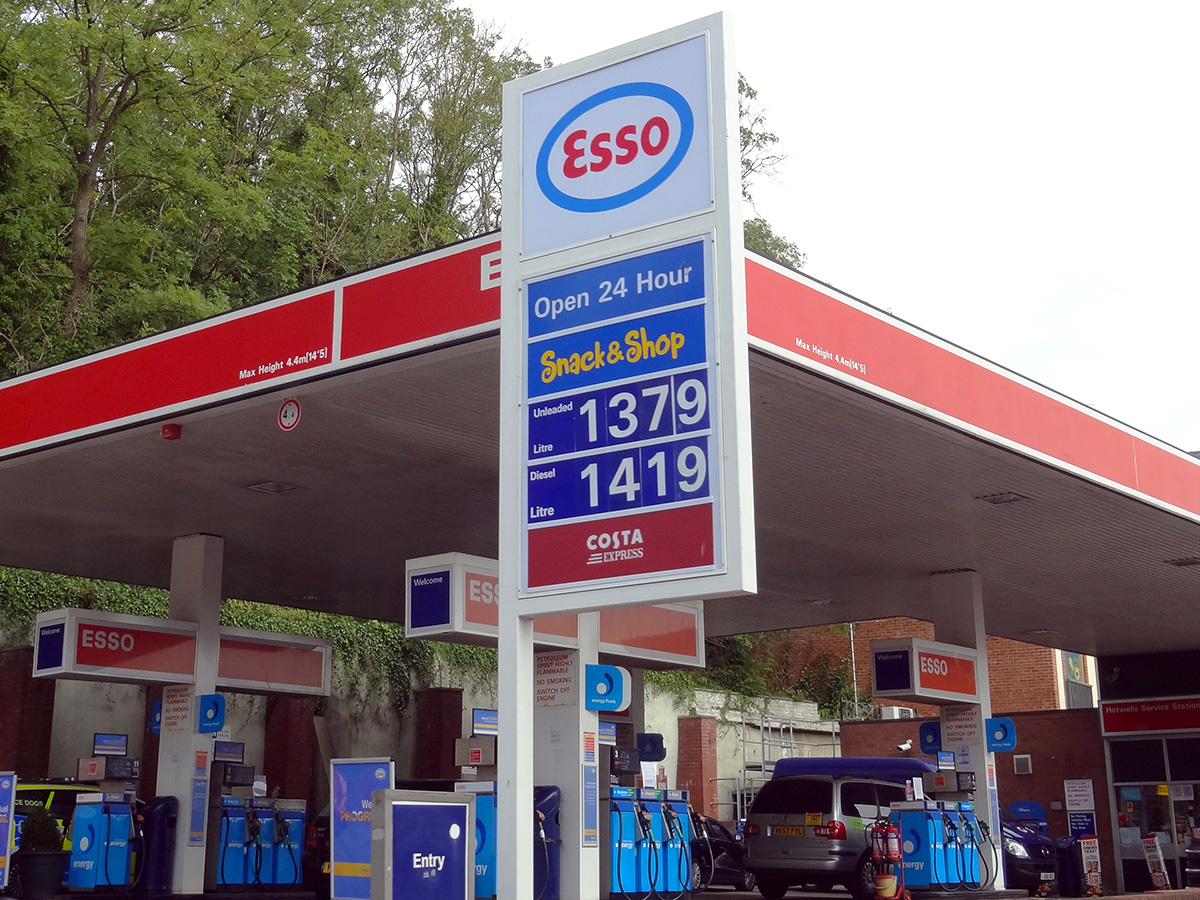 Raise fuel and/or other duties. Fuel duties raise approximately £24 billion. They are set to decline gradually with the shift to EVs and more fuel-efficient internal combustion engines. Fuel duty remained unchanged at 57.95p per litre from 2011 to 2022 and then was ‘temporarily’ cut to 52.95p. The rate of 52.95p is set to remain until at least 2026. There is clearly scope here to raise it, if only by the rate of inflation each year. Again, the main problem is a political one that drivers and the motor lobby generally will complain. Other duties include alcohol, tobacco/cigarettes/vaping, high-sugar beverages and gambling. Again, there is scope for raising these. There are two problems here. The first is that these duties are regressive, falling more heavily on poorer people. The second is that high duties can encourage illegal trade in these products.
Raise fuel and/or other duties. Fuel duties raise approximately £24 billion. They are set to decline gradually with the shift to EVs and more fuel-efficient internal combustion engines. Fuel duty remained unchanged at 57.95p per litre from 2011 to 2022 and then was ‘temporarily’ cut to 52.95p. The rate of 52.95p is set to remain until at least 2026. There is clearly scope here to raise it, if only by the rate of inflation each year. Again, the main problem is a political one that drivers and the motor lobby generally will complain. Other duties include alcohol, tobacco/cigarettes/vaping, high-sugar beverages and gambling. Again, there is scope for raising these. There are two problems here. The first is that these duties are regressive, falling more heavily on poorer people. The second is that high duties can encourage illegal trade in these products.
Raising one of the three major taxes: income tax, employees’ national insurance and VAT. This will involve reneging on the government’s election promises. But perhaps it’s better to bite the bullet and do it sooner rather than later. Six European countries have VAT rates of 21%, three of 22%, three of 23%, two of 24%, four of 25%, one of 25.5% and one of 27%. Each one percentage point rise would raise about 9 billion. A one percentage point rise across all UK income tax rates would raise around £5.8 billion. As far as employees’ national insurance rates are concerned, the Conservative government reduced the main rate twice from 12% to 10% in January 2024 and from 10% to 8% in April 2024. The government could argue that raising it back to, say, 10% would still leave it lower than previously. A rise to 10% would raise around £11 billion.
Conclusion
The choices for the Chancellor are not easy. As the NIESR’s Economic Outlook puts it:
Simply put, the Chancellor cannot simultaneously meet her fiscal rules, fulfil spending commitments, and uphold manifesto promises to avoid tax rises for working people. At least one of these will need to be dropped – she faces an impossible trilemma.
Articles
- The Chancellor’s Trilemma
UK Economic Outlook: NIESR, Benjamin Caswell, Fergus Jimenez-England, Hailey Low, Stephen Millard, Eliza da Silva Gomes, Adrian Pabst, Tibor Szendrei and Arnab Bhattacharjee (6/8/25)
- Reeves must raise tax to cover £41bn gap, says think tank
BBC News, Lucy Hooker (6/8/25)
- Chancellor warned ‘substantial tax rises’ needed – as she faces ‘impossible trilemma’
Sky News, Gurpreet Narwan (6/8/25)
- Rachel Reeves needs to put up taxes to cover £40bn deficit, thinktank says
The Guardian, Phillip Inman (6/8/25)
- What’s the secret to fixing the UK’s public finances? Here’s what our panel of experts would do
The Conversation, Steve Schifferes, Conor O’Kane, Guilherme Klein Martins, Jonquil Lowe and Maha Rafi Atal (15/8/25)
- Why radical tax reform may be only way for Reeves to balance the books
The Guardian, Phillip Inman (21/8/25)
- Reeves and Starmer to prepare ground for tax rises in a difficult autumn budget
The Guardian, Jessica Elgot, Richard Partington and Eleni Courea (7/8/25)
- How much money does the UK government borrow, and does it matter?
BBC News (21/8/25)
- More pain for Reeves as government borrowing cost nears 27-year high
The Guardian, Phillip Inman (26/8/25)
Data
Questions
- Which of the options would you choose and why?
- Should the government introduce a wealth tax on people with wealth above, say, £2 million? If so, should it be a once-only tax or an annual tax?
- Research another country’s fiscal position and assess the choices their finance minister took.
- Look at a previous UK Budget from a few years ago and the forecasts on which the Budget decisions were made (search Budget [year] on the GOV.UK website). How accurate did the forecasts turn out to be? If the Chancellor then had known what would actually happen in the future, would their decisions have been any different and, if so, in what ways?
- Should fiscal decisions be based on forecasts for three of four years hence when those forecasts are likely to be unreliable?
- Should fiscal and monetary policy decisions be made totally separately from each other?
 In a blog in October 2024, we looked at global uncertainty and how it can be captured in a World Uncertainty Index. The blog stated that ‘We continue to live through incredibly turbulent times. In the past decade or so we have experienced a global financial crisis, a global health emergency, seen the UK’s departure from the European Union, and witnessed increasing levels of geopolitical tension and conflict’.
In a blog in October 2024, we looked at global uncertainty and how it can be captured in a World Uncertainty Index. The blog stated that ‘We continue to live through incredibly turbulent times. In the past decade or so we have experienced a global financial crisis, a global health emergency, seen the UK’s departure from the European Union, and witnessed increasing levels of geopolitical tension and conflict’.
Since then, Donald Trump has been elected for a second term and has introduced sweeping tariffs. What is more, the tariffs announced on so-called ‘Liberation Day‘ have not remained fixed, but have fluctuated with negotiations and threatened retaliation. The resulting uncertainty makes it very hard for businesses to plan and many have been unwilling to commit to investment decisions. The uncertainty has been compounded by geopolitical events, such as the continuing war in Ukraine, the war in Gaza and the June 13 Israeli attack on Iran.
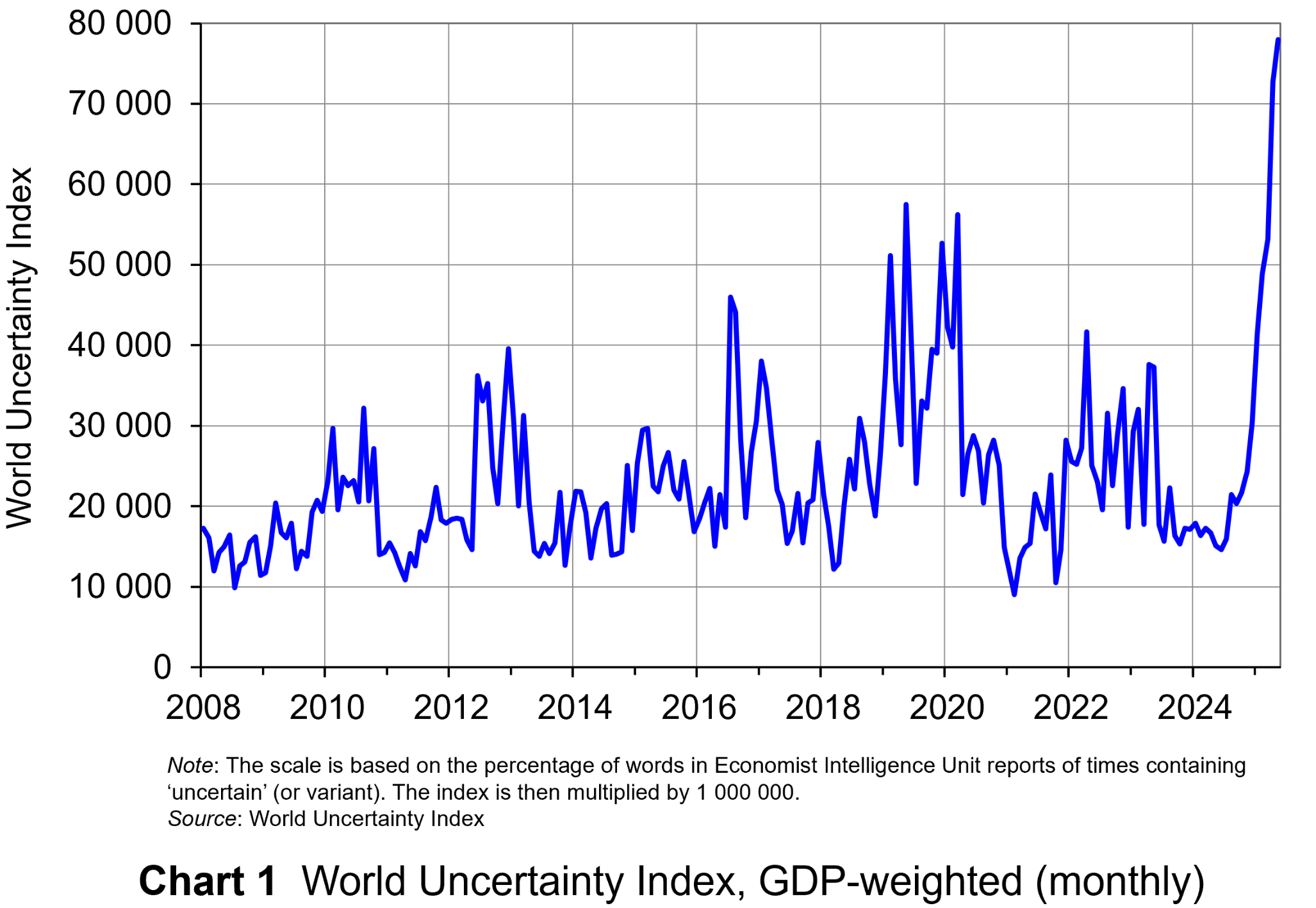 The World Uncertainty Index (WUI) tracks uncertainty around the world by applying a form of text mining known as ‘term frequency’ to the country reports produced by the Economist Intelligence Unit (EIU). The words searched for are ‘uncertain’, ‘uncertainty’ and ‘uncertainties’ and the number of times they occur as percentage of the total words is recorded. To produce the WUI this figure is then multiplied by 1m. A higher WUI number indicates a greater level of uncertainty.
The World Uncertainty Index (WUI) tracks uncertainty around the world by applying a form of text mining known as ‘term frequency’ to the country reports produced by the Economist Intelligence Unit (EIU). The words searched for are ‘uncertain’, ‘uncertainty’ and ‘uncertainties’ and the number of times they occur as percentage of the total words is recorded. To produce the WUI this figure is then multiplied by 1m. A higher WUI number indicates a greater level of uncertainty.
The monthly global average WUI is shown in Chart 1 (click here for a PowerPoint). It is based on 71 countries. Since 2008 the WUI has averaged a little over 23 000: i.e. 2.3 per cent of the text in EIU reports contains the word ‘uncertainty’ or a close variant. In May 2025, it was almost 79 000 – the highest since the index was first complied in 2008. The previous highest was in March 2020, at the start of the COVID-19 outbreak, when the index rose to just over 56 000.
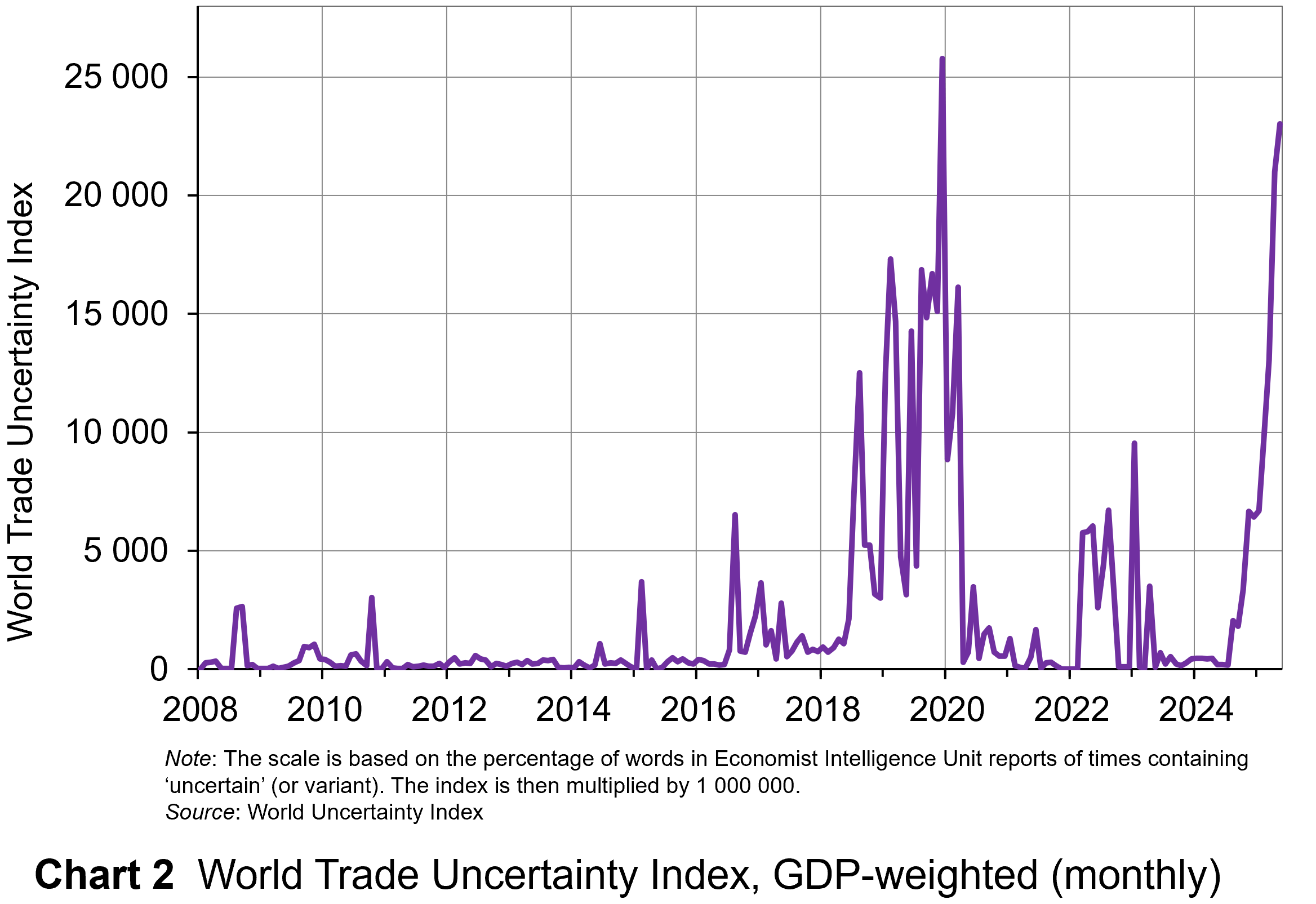 The second chart shows the World Trade Uncertainty Index (WTUI), published on the same site as the WUI (click here for a PowerPoint). The method adopted in its construction therefore mirrors that for the WUI but counts the number of times in EIU country reports ‘uncertainty’ is mentioned within proximity to a word related to trade, such as ‘protectionism’, ‘NAFTA’, ‘tariff’, ‘trade’, ‘UNCTAD’ or ‘WTO.’
The second chart shows the World Trade Uncertainty Index (WTUI), published on the same site as the WUI (click here for a PowerPoint). The method adopted in its construction therefore mirrors that for the WUI but counts the number of times in EIU country reports ‘uncertainty’ is mentioned within proximity to a word related to trade, such as ‘protectionism’, ‘NAFTA’, ‘tariff’, ‘trade’, ‘UNCTAD’ or ‘WTO.’
The chart shows that in May 2025, the WTUI had risen to just over 23 000 – the second highest since December 2019, when President Trump imposed a new round of tariffs on Chinese imports and announced that he would restore steel tariffs on Brazil and Argentina. Since 2008, the WTUI has averaged just 2228.
It remains to be seen whether more stability in trade relations and geopolitics will allow WUI and WUTI to decline once more, or whether greater instability will simply lead to greater uncertainty, with damaging consequences for investment and also for consumption and employment.
Articles
- IMF World Economic Outlook: economic uncertainty is now higher than it ever was during COVID
The Conversation, Sergi Basco (23/4/25)
- Economic uncertainty hits new high
McKinsey, Sven Smit et al. (29/5/25)
- Trade tensions and rising uncertainty drag global economy towards recession
UNCTAD News (25/4/25)
- IMF Warns Global Economic Uncertainty Surpasses Pandemic Levels
The Global Treasurer (24/4/25)
- Britons ‘hoarding cash amid economic uncertainty and fear of outages’
The Guardian, Phillip Inman (10/6/25)
- America’s Brexit Phase
Foreign Affairs, Jonathan Haskel and Matthew J. Slaughter (10/6/25)
- Goldman Sachs’ CEO on the ‘Big, Beautiful Bill,’ Trump’s Tariffs and Economic Volatility
Politico, Sam Sutton (13/6/25)
- The Countries Where Economic Uncertainty Is Rising Fastest
24/7 Wall St., Evan Comen (9/6/25)
- Trump’s tariffs have finally kicked in, so what happens next?
The Conversation, Maha Rafi Atal (8/8/25)
Uncertainty Indices
Questions
- Explain what is meant by ‘text mining’. What are its strengths and weaknesses in assessing business, consumer and trade uncertainty?
- Explain how the UK Monthly EPU Index is derived.
- Why has uncertainty increased so dramatically since the start of 2025?
- Compare indices based on text mining with confidence indices.
- Plot consumer and business/industry confidence indicators for the past 24 months, using EC data. Do they correspond with the WUI?
- How may uncertainty affect consumers’ decisions?
 Following the controversary over the sale of tickets for popular live events such as Taylor Swift’s Eras tour and the Oasis Live ’25 Tour, the government launched a consultation exercise in January 2025 on the resale of tickets. Titled, ‘putting fans first’, the exercise sought the views of individuals and organisations on a range of policy proposals. One of these was the implementation of a cap on the resale price of tickets.
Following the controversary over the sale of tickets for popular live events such as Taylor Swift’s Eras tour and the Oasis Live ’25 Tour, the government launched a consultation exercise in January 2025 on the resale of tickets. Titled, ‘putting fans first’, the exercise sought the views of individuals and organisations on a range of policy proposals. One of these was the implementation of a cap on the resale price of tickets. Although many fans dislike the uncapped secondary ticketing market, most economists take a more positive view. They see them as a way of facilitating mutually beneficial trade and helping to reallocate tickets to those with the highest willingness to pay. This reduces levels of allocative inefficiency/deadweight welfare loss in the market.
Although many fans dislike the uncapped secondary ticketing market, most economists take a more positive view. They see them as a way of facilitating mutually beneficial trade and helping to reallocate tickets to those with the highest willingness to pay. This reduces levels of allocative inefficiency/deadweight welfare loss in the market. Given the benefits outlined by economists of having an uncapped secondary ticketing, why is the government considering the implementation of a price cap? One potential issue of having an uncapped secondary ticketing market is that developments in technology make it easier for professional resellers to buy very large quantities of tickets. This makes it increasingly difficult for fans who want to attend the event from being able to purchase a ticket.
Given the benefits outlined by economists of having an uncapped secondary ticketing, why is the government considering the implementation of a price cap? One potential issue of having an uncapped secondary ticketing market is that developments in technology make it easier for professional resellers to buy very large quantities of tickets. This makes it increasingly difficult for fans who want to attend the event from being able to purchase a ticket. One issue raised in the response to the consultation by the Competition and Markets Authority is that these fees are not always made clear by sellers in the primary market in a clear and transparent way. Therefore, for the policy to be effective, primary market sellers would have to make information on both ticket prices and any fees clearly and easily available. Recent changes to the law that prohibit drip pricing might help to address this issue.
One issue raised in the response to the consultation by the Competition and Markets Authority is that these fees are not always made clear by sellers in the primary market in a clear and transparent way. Therefore, for the policy to be effective, primary market sellers would have to make information on both ticket prices and any fees clearly and easily available. Recent changes to the law that prohibit drip pricing might help to address this issue.  To avoid the price cap, there is a danger that increasing numbers of buyers and sellers stop using capped secondary ticket platforms, where activity is easier to observe/regulate, and switch to other non-specialist platforms where detection of illegal behaviour and enforcement of consumer law is more difficult. Examples of non-specialist platforms where sales might increasingly take place include Facebook Marketplace, Instagram Shop, X (formerly Twitter) and internet forums. With lower levels of consumer protection and the greater difficulty of detecting illegal behaviour, sales via these non-specialist platforms are more vulnerable to scams and fraud.
To avoid the price cap, there is a danger that increasing numbers of buyers and sellers stop using capped secondary ticket platforms, where activity is easier to observe/regulate, and switch to other non-specialist platforms where detection of illegal behaviour and enforcement of consumer law is more difficult. Examples of non-specialist platforms where sales might increasingly take place include Facebook Marketplace, Instagram Shop, X (formerly Twitter) and internet forums. With lower levels of consumer protection and the greater difficulty of detecting illegal behaviour, sales via these non-specialist platforms are more vulnerable to scams and fraud. Scams and Scandals: the Great Ticket Rip-Off
Scams and Scandals: the Great Ticket Rip-Off The UK’s poor record on productivity since the 2008 financial crisis is well documented, not least in this blog series. Output per worker has flatlined over the 17 years since the crisis. As was noted in the blog,
The UK’s poor record on productivity since the 2008 financial crisis is well documented, not least in this blog series. Output per worker has flatlined over the 17 years since the crisis. As was noted in the blog,  From Figure 1 it can be observed that, since the mid-1990s, the UK has consistently had lower investment as a percentage of GDP compared to other significant developed market economies. The cumulative effect of this gap has contributed to lower productivity and lower economic growth.
From Figure 1 it can be observed that, since the mid-1990s, the UK has consistently had lower investment as a percentage of GDP compared to other significant developed market economies. The cumulative effect of this gap has contributed to lower productivity and lower economic growth. Analysis by the OECD suggest that, while the cost of financing investment has declined since the financial crisis, the gap between this and the hurdle rate used to appraise investments has widened. Between 2010 and 2021 the difference nearly doubled to 4%. This increase in the hurdle rate can be related to increases in the expected rate of return by UK companies and their investors.
Analysis by the OECD suggest that, while the cost of financing investment has declined since the financial crisis, the gap between this and the hurdle rate used to appraise investments has widened. Between 2010 and 2021 the difference nearly doubled to 4%. This increase in the hurdle rate can be related to increases in the expected rate of return by UK companies and their investors. 
 However, it is not interest rates that have increased the opportunity cost, and hence the minimum expected rate of return associated with investment, in the UK since the financial crisis. For most of the period since 2008, interest rates have been extremely low, sitting at below 1%, only rising significantly during the post-pandemic inflationary surge in 2022. This indicates that this source of opportunity cost for the commitment of business investment has been extremely low.
However, it is not interest rates that have increased the opportunity cost, and hence the minimum expected rate of return associated with investment, in the UK since the financial crisis. For most of the period since 2008, interest rates have been extremely low, sitting at below 1%, only rising significantly during the post-pandemic inflationary surge in 2022. This indicates that this source of opportunity cost for the commitment of business investment has been extremely low.
 There has been much discussion of increased uncertainty and risk aversion among global investors and firms (see the blogs
There has been much discussion of increased uncertainty and risk aversion among global investors and firms (see the blogs  Figure 2 illustrates the monthly index from 1998 to July 2025. The series is normalised to standard deviation 1 prior to 2011 and then summed across papers, by month. Then, the series is normalised to mean 100 prior to 2011.
Figure 2 illustrates the monthly index from 1998 to July 2025. The series is normalised to standard deviation 1 prior to 2011 and then summed across papers, by month. Then, the series is normalised to mean 100 prior to 2011. Over the past 10 years, policy uncertainty has played a significant role in deterring investment. So, if there is greater continuity, this may then promote higher levels of investment.
Over the past 10 years, policy uncertainty has played a significant role in deterring investment. So, if there is greater continuity, this may then promote higher levels of investment. The UK energy regulator, Ofgem, has announced that the UK energy price cap will rise in October by an average of 2%. The energy price cap sets the maximum prices for electricity and gas that can be charged by suppliers to households. For those paying by direct debit, the maximum electricity price per kilowatt-hour (kWh) will rise from 25.73p to 26.35p, with the maximum daily standing charge rising from 51.37p to 53.68p. As far as gas is concerned, the maximum price per kWh will fall slightly from 6.33p to 6.29p, with the maximum daily standing charge rising from 29.82p to 34.03p. Ofgem estimates that this will mean that the capped cost to the average household will rise from £1720 to £1755.
The UK energy regulator, Ofgem, has announced that the UK energy price cap will rise in October by an average of 2%. The energy price cap sets the maximum prices for electricity and gas that can be charged by suppliers to households. For those paying by direct debit, the maximum electricity price per kilowatt-hour (kWh) will rise from 25.73p to 26.35p, with the maximum daily standing charge rising from 51.37p to 53.68p. As far as gas is concerned, the maximum price per kWh will fall slightly from 6.33p to 6.29p, with the maximum daily standing charge rising from 29.82p to 34.03p. Ofgem estimates that this will mean that the capped cost to the average household will rise from £1720 to £1755. The average capped cost is now much lower than the peak of £4279 from January to March 2023. This followed the huge increase in international gas prices in the aftermath of the invasion of Ukraine and the cutting off of gas supplies from Russia. Note that although the suppliers received these capped prices, average consumers’ bills were limited to £2500 from October 2022 to March 2024 under the government’s Energy Price Guarantee scheme, with suppliers receiving a subsidy from the government to make up the shortfall. But despite today’s cap being much lower than at the peak, it is still much higher than the cap of £1277 prior to Russia’s invasion of Ukraine: see Chart 1 (click
The average capped cost is now much lower than the peak of £4279 from January to March 2023. This followed the huge increase in international gas prices in the aftermath of the invasion of Ukraine and the cutting off of gas supplies from Russia. Note that although the suppliers received these capped prices, average consumers’ bills were limited to £2500 from October 2022 to March 2024 under the government’s Energy Price Guarantee scheme, with suppliers receiving a subsidy from the government to make up the shortfall. But despite today’s cap being much lower than at the peak, it is still much higher than the cap of £1277 prior to Russia’s invasion of Ukraine: see Chart 1 (click  As far as gas prices are concerned, the price does largely reflect the international price: see Chart 2 (click
As far as gas prices are concerned, the price does largely reflect the international price: see Chart 2 (click  Electricity generation costs vary considerably with the different methods. Renewable sources like wind and solar have the lowest marginal costs, while natural gas plants have the highest, although gas prices fluctuate considerably.
Electricity generation costs vary considerably with the different methods. Renewable sources like wind and solar have the lowest marginal costs, while natural gas plants have the highest, although gas prices fluctuate considerably.  It also means that profits for low-marginal-cost producers could increase significantly when gas prices rise. To prevent such (low-carbon) suppliers making excess profits when the wholesale price is high and possibly making a loss when it is low, the actual prices that they receive is negotiated in advance and a contract is signed. These contracts are known as Contracts for Difference (CfDs). CfDs provide a fixed ‘strike price’ to low-carbon generators. The strike price is set so as to allow low-carbon generators to recoup capital costs and is thus set above the typical level of marginal cost. If the wholesale price is below the strike price, payments to generators to cover the difference are funded by amounts collected from electricity suppliers in advance using the CfD Supplier Obligation Levy. If the wholesale price is above the strike price, the difference is returned to consumers in terms of lower electricity bills.
It also means that profits for low-marginal-cost producers could increase significantly when gas prices rise. To prevent such (low-carbon) suppliers making excess profits when the wholesale price is high and possibly making a loss when it is low, the actual prices that they receive is negotiated in advance and a contract is signed. These contracts are known as Contracts for Difference (CfDs). CfDs provide a fixed ‘strike price’ to low-carbon generators. The strike price is set so as to allow low-carbon generators to recoup capital costs and is thus set above the typical level of marginal cost. If the wholesale price is below the strike price, payments to generators to cover the difference are funded by amounts collected from electricity suppliers in advance using the CfD Supplier Obligation Levy. If the wholesale price is above the strike price, the difference is returned to consumers in terms of lower electricity bills.
 The UK Chancellor of the Exchequer, Rachel Reeves, will present her annual Budget in late autumn. It will involve some hard economic and political choices. The government would like to spend more money on improving public services but has pledged not to raise taxes ‘on working people’, which is interpreted as not raising the rates of income tax, national insurance for employees and the self-employed, and VAT. What is more, government borrowing is forecast by the OBR to be £118 billion, or nearly 4.0% of GDP, for the the year 2025/26. This is a fall from the 5.1% in 2024/25 and is well below the 15.0% in 2020/21 during the pandemic. But it is significantly above the 2.1% in 2018/19.
The UK Chancellor of the Exchequer, Rachel Reeves, will present her annual Budget in late autumn. It will involve some hard economic and political choices. The government would like to spend more money on improving public services but has pledged not to raise taxes ‘on working people’, which is interpreted as not raising the rates of income tax, national insurance for employees and the self-employed, and VAT. What is more, government borrowing is forecast by the OBR to be £118 billion, or nearly 4.0% of GDP, for the the year 2025/26. This is a fall from the 5.1% in 2024/25 and is well below the 15.0% in 2020/21 during the pandemic. But it is significantly above the 2.1% in 2018/19. The government has pledged to stick to its two fiscal rules. The first is that the day-to-day, or ‘current’, budget (i.e. excluding investment) should be in surplus or in deficit of no more than 0.5 per cent of GDP by 2029/30 (or the third year of the rolling forecast period from the 2026/27 Budget). This allows investment to be funded by borrowing. The second rule is that public-sector net debt, which includes public-sector debt plus pension liabilities minus equity, loans and other financial assets, should be falling by 2029/30 (or the third year of the rolling forecast period from the 2026/27 Budget). The current budget deficit (i.e. excluding borrowing for investment) was forecast by the OBR in March to be 1.2% of GDP for 2025/26 (see Chart 1) and to be a surplus of 0.3% in 2029/30 (£9.9 billion). (Click
The government has pledged to stick to its two fiscal rules. The first is that the day-to-day, or ‘current’, budget (i.e. excluding investment) should be in surplus or in deficit of no more than 0.5 per cent of GDP by 2029/30 (or the third year of the rolling forecast period from the 2026/27 Budget). This allows investment to be funded by borrowing. The second rule is that public-sector net debt, which includes public-sector debt plus pension liabilities minus equity, loans and other financial assets, should be falling by 2029/30 (or the third year of the rolling forecast period from the 2026/27 Budget). The current budget deficit (i.e. excluding borrowing for investment) was forecast by the OBR in March to be 1.2% of GDP for 2025/26 (see Chart 1) and to be a surplus of 0.3% in 2029/30 (£9.9 billion). (Click  A forecast earlier this month by the National Institute for Economic and Social Research (NIESR) (see link below and Chart 2) reflects these problems and paints a gloomier picture than the OBR’s March forecast. The NIESR forecasts that GDP will grow by only 1.3 per cent in 2025, 1.2 per cent in 2026, 1.1% in 2027 and 1.0% in 2028, with the average for 2025 to 2023 being 1.13%. This is the result of high levels of business uncertainty and the effects of tariffs on exports. With no change in policy, the current deficit would be £41.2 billion in the 2029/30 financial year. Inflation would fall somewhat, but would stick at around 2.7% from 2028 to 2030. Net debt would be rising in 2029/30 &ndash but only slightly, from 98.7% to 99.0%. (Click
A forecast earlier this month by the National Institute for Economic and Social Research (NIESR) (see link below and Chart 2) reflects these problems and paints a gloomier picture than the OBR’s March forecast. The NIESR forecasts that GDP will grow by only 1.3 per cent in 2025, 1.2 per cent in 2026, 1.1% in 2027 and 1.0% in 2028, with the average for 2025 to 2023 being 1.13%. This is the result of high levels of business uncertainty and the effects of tariffs on exports. With no change in policy, the current deficit would be £41.2 billion in the 2029/30 financial year. Inflation would fall somewhat, but would stick at around 2.7% from 2028 to 2030. Net debt would be rising in 2029/30 &ndash but only slightly, from 98.7% to 99.0%. (Click  The second problem is that the Chancellor has said that she will stick to the fiscal rules. If she scraps them, if only temporarily, she runs the risk of losing the confidence of investors. This could lead to a run on the pound and even higher interest rates. This was a problem under the short-lived Liz Truss government when the ‘mini’ Budget of September 2022 made unfunded pledges to cut taxes. There was a run on the pound and the Bank of England had to make emergency gilt purchases.
The second problem is that the Chancellor has said that she will stick to the fiscal rules. If she scraps them, if only temporarily, she runs the risk of losing the confidence of investors. This could lead to a run on the pound and even higher interest rates. This was a problem under the short-lived Liz Truss government when the ‘mini’ Budget of September 2022 made unfunded pledges to cut taxes. There was a run on the pound and the Bank of England had to make emergency gilt purchases. The current government has launched a Public Sector Productivity Programme. This is a a cross-government initiative to improve productivity across public services. Departments are required to develop productivity plans to invest in schemes designed to achieve cost savings and improve outcomes in areas such as the NHS, police, and justice system. A £1.8 billion fund was announced in March 2024, to support public-sector productivity improvements and digital transformation. Part of this is to be invested in digital services and AI to improve efficiency.
The current government has launched a Public Sector Productivity Programme. This is a a cross-government initiative to improve productivity across public services. Departments are required to develop productivity plans to invest in schemes designed to achieve cost savings and improve outcomes in areas such as the NHS, police, and justice system. A £1.8 billion fund was announced in March 2024, to support public-sector productivity improvements and digital transformation. Part of this is to be invested in digital services and AI to improve efficiency.  Cutting tax relief for pensions. Currently, people get income tax relief at their marginal rate on pension contributions made by themselves and their employer up to £60 000 per year or 100% of their earnings, whichever is smaller. When people draw on their pension savings, they pay income tax at their marginal rate, even if the size of their savings has grown from capital gains, interest or dividends. Reducing the limits or restricting relief to the basic rate of tax could make a substantial contribution to increasing government revenue. In 2023/24, pension contribution relief cost the government £52 billion. Restricting relief to the basic rate or cutting the annual limit would make the relief less regressive. In such a case, when people draw on their pension savings, the income tax rate could be limited to the basic rate to avoid double taxation.
Cutting tax relief for pensions. Currently, people get income tax relief at their marginal rate on pension contributions made by themselves and their employer up to £60 000 per year or 100% of their earnings, whichever is smaller. When people draw on their pension savings, they pay income tax at their marginal rate, even if the size of their savings has grown from capital gains, interest or dividends. Reducing the limits or restricting relief to the basic rate of tax could make a substantial contribution to increasing government revenue. In 2023/24, pension contribution relief cost the government £52 billion. Restricting relief to the basic rate or cutting the annual limit would make the relief less regressive. In such a case, when people draw on their pension savings, the income tax rate could be limited to the basic rate to avoid double taxation. Raise fuel and/or other duties. Fuel duties raise approximately £24 billion. They are set to decline gradually with the shift to EVs and more fuel-efficient internal combustion engines. Fuel duty remained unchanged at 57.95p per litre from 2011 to 2022 and then was ‘temporarily’ cut to 52.95p. The rate of 52.95p is set to remain until at least 2026. There is clearly scope here to raise it, if only by the rate of inflation each year. Again, the main problem is a political one that drivers and the motor lobby generally will complain. Other duties include alcohol, tobacco/cigarettes/vaping, high-sugar beverages and gambling. Again, there is scope for raising these. There are two problems here. The first is that these duties are regressive, falling more heavily on poorer people. The second is that high duties can encourage illegal trade in these products.
Raise fuel and/or other duties. Fuel duties raise approximately £24 billion. They are set to decline gradually with the shift to EVs and more fuel-efficient internal combustion engines. Fuel duty remained unchanged at 57.95p per litre from 2011 to 2022 and then was ‘temporarily’ cut to 52.95p. The rate of 52.95p is set to remain until at least 2026. There is clearly scope here to raise it, if only by the rate of inflation each year. Again, the main problem is a political one that drivers and the motor lobby generally will complain. Other duties include alcohol, tobacco/cigarettes/vaping, high-sugar beverages and gambling. Again, there is scope for raising these. There are two problems here. The first is that these duties are regressive, falling more heavily on poorer people. The second is that high duties can encourage illegal trade in these products. The World Uncertainty Index (WUI) tracks uncertainty around the world by applying a form of text mining known as ‘term frequency’ to the
The World Uncertainty Index (WUI) tracks uncertainty around the world by applying a form of text mining known as ‘term frequency’ to the  The second chart shows the World Trade Uncertainty Index (WTUI), published on the
The second chart shows the World Trade Uncertainty Index (WTUI), published on the